Siladen Fish Glossary
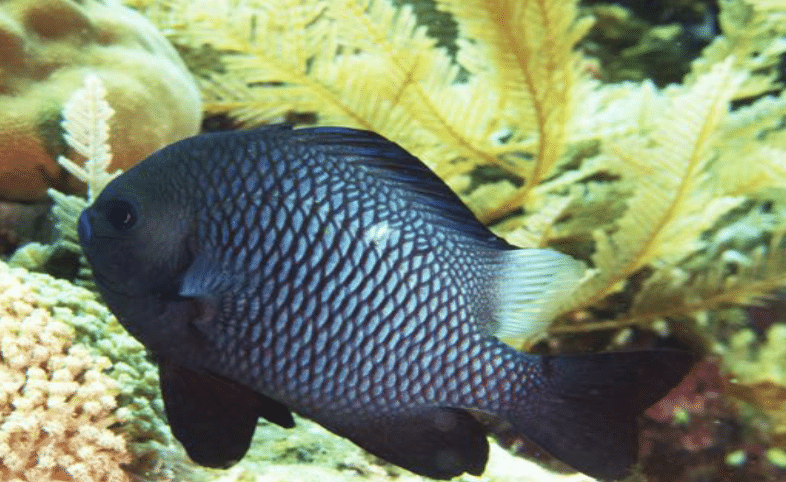
Threespot Dascyllus
(Dascyllus trimaculatus)
This fish, also known as the Three-spot Humbug, is a small damselfish characterized by three distinctive spots along its body. It typically inhabits coral reefs in the Indo-Pacific region, often seen darting in and out of crevices for protection
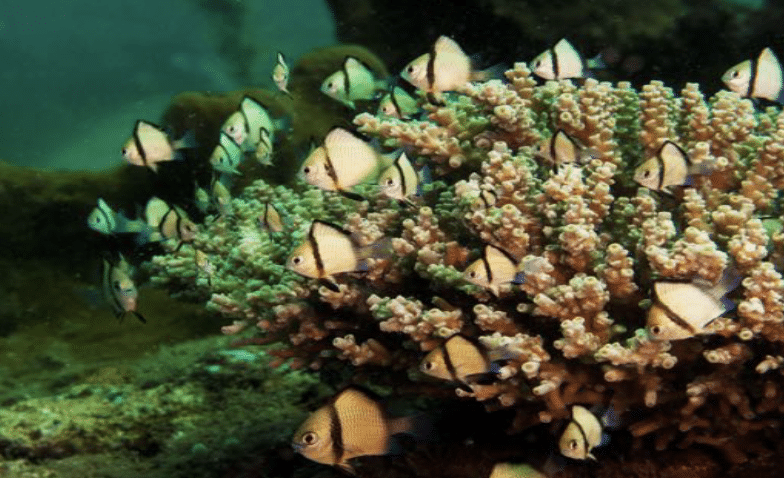
Reticulate Dascyllus
(Dascyllus reticulatus)
The Reticulate Dascyllus is another species of damselfish found in the Indo-Pacific region. It has a reticulated or net-like pattern on its body, hence the name. These fish are often seen in large schools around coral reefs.
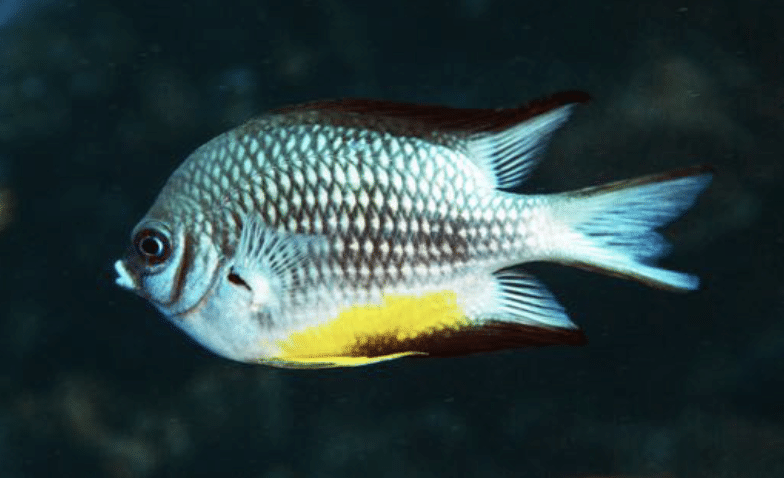
White-belly Damsel
(Amblyglyphidodon leucogaster)
This damselfish species is distinguished by its white belly and yellowish body. It inhabits lagoons and protected reef areas, feeding on small invertebrates and algae.
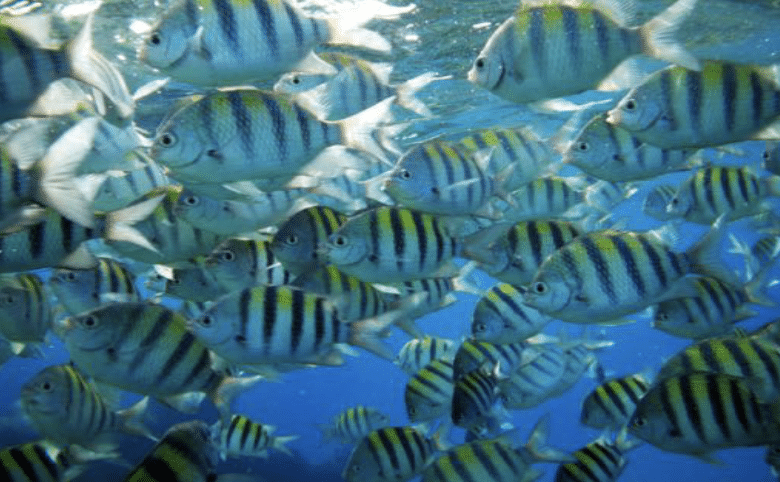
Sergeant Major
(Abudefduf vaigensiis)
The Sergeant Major is a colorful reef fish known for its distinctive five vertical black bars on a yellow body. It’s found in tropical waters worldwide and often seen in large schools near coral reefs.
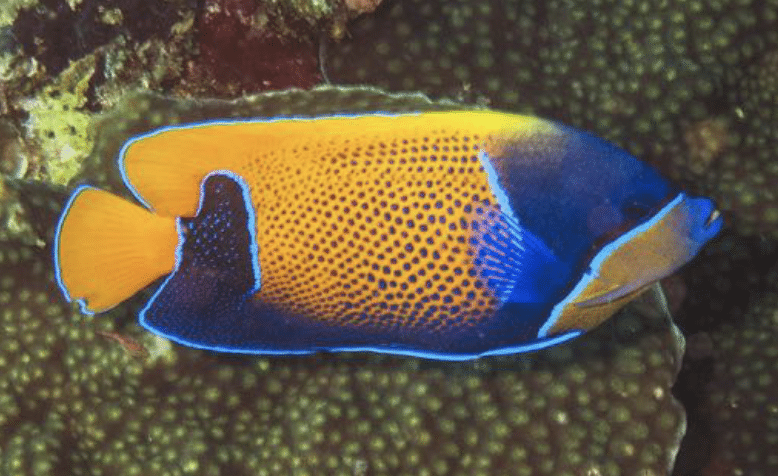
Blue-girdled Angelfish
(Pomacanthus navarchus)
This angelfish species is characterized by a prominent blue band running diagonally across its body, giving it its name. It inhabits coral reefs in the Indo-Pacific and can grow to a considerable size.
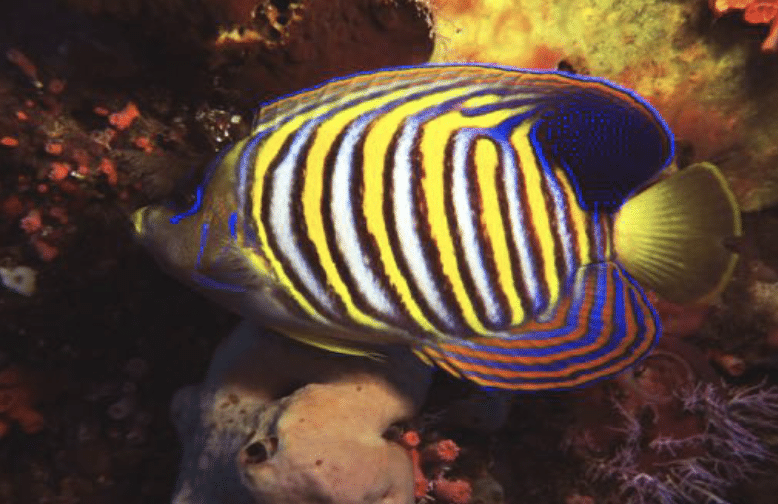
Regal Angelfish
(Pygoplithes diacanthus)
The Regal Angelfish is a beautifully colored species with vibrant blue and yellow stripes. It’s found in the Indo-Pacific region, often near steep outer reef slopes and drop-offs.
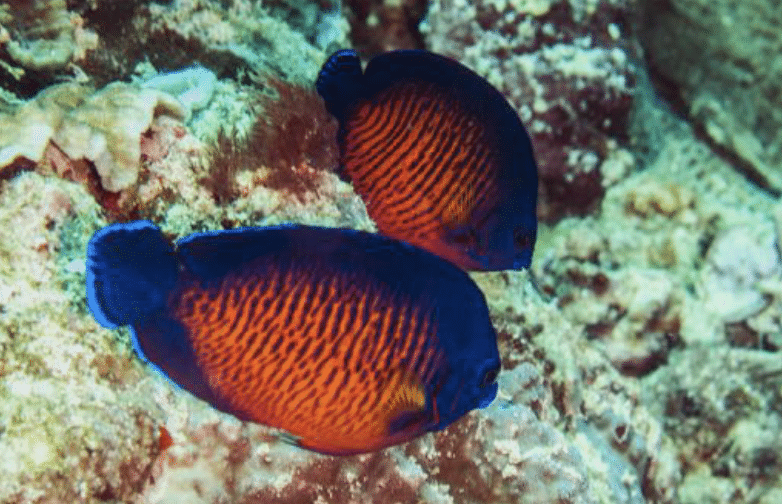
Two-spined Angelfish
(Centropyge bispinosus)
This smaller species of angelfish is characterized by two prominent spines on its operculum. It’s found in coral-rich areas of the Indo-Pacific and is popular in the aquarium trade.
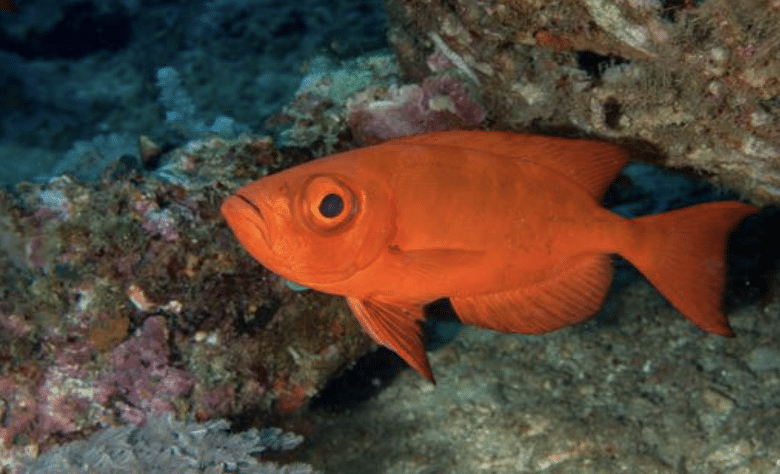
Crescent-tail Bigeye
(Priacanthus hamrur)
This fish, also known as the Bigeye, has a distinctive crescent-shaped tail and large eyes. It inhabits reef slopes and deeper waters, feeding primarily on small fish and crustaceans.
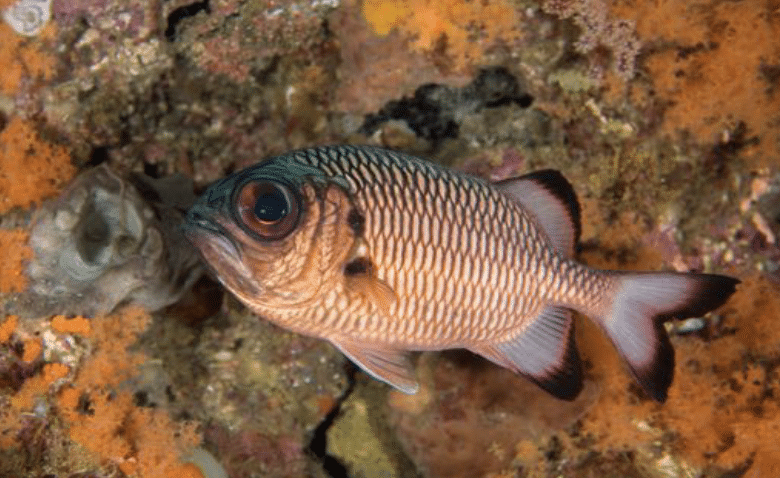
Shadowfin Soldierfish
(Myripristis adusta)
These soldierfish are characterized by their deep red coloration and dark fins. They inhabit caves and crevices in coral reefs, emerging at night to feed on small invertebrates.
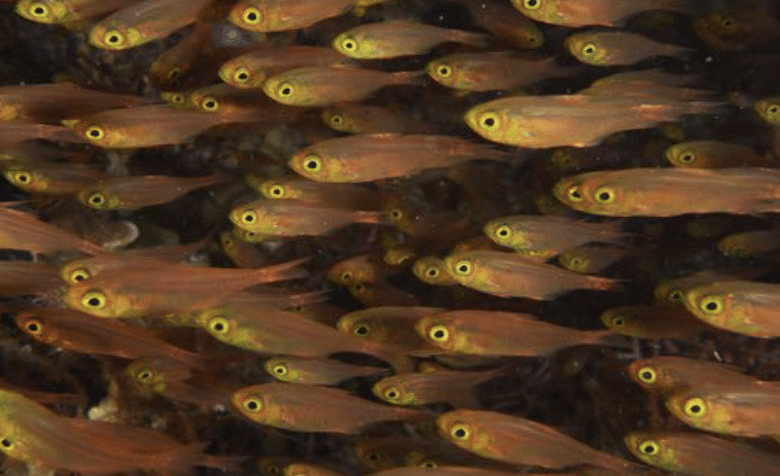
Golden Sweeper
(Parapriacanthus ransonneti)
The Golden Sweeper is a slender, elongated fish with a bright golden-yellow body. It forms large schools in open waters and is often found in association with coral reefs in the Indo-Pacific.
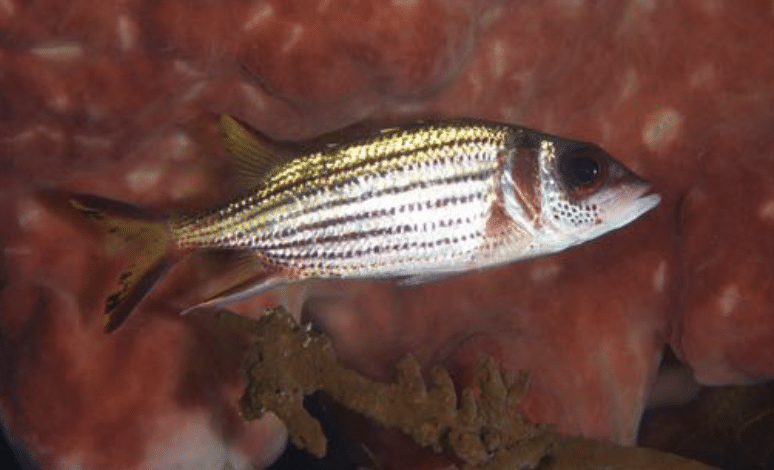
Spotfin Squirrelfish
(Neoniphon sammara)
This squirrelfish species has a reddish body with distinctive black spots on its dorsal fin, hence the name. It inhabits coral reefs and rocky areas, often hiding in crevices during the day and emerging at night to feed.
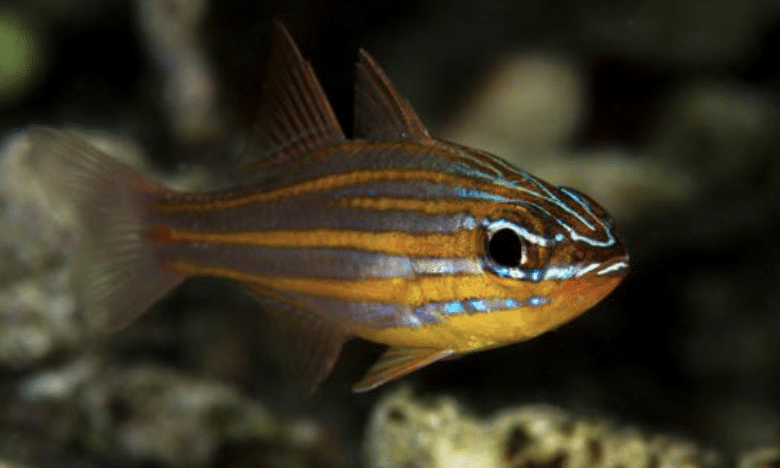
Yellow striped Cardinalfish
(Apogon cyanosoma)
As the name suggests, this cardinalfish species has prominent yellow stripes running along its body. It’s found in the Indo-Pacific region, often hiding among coral branches or rubble during the day and forming schools at night.
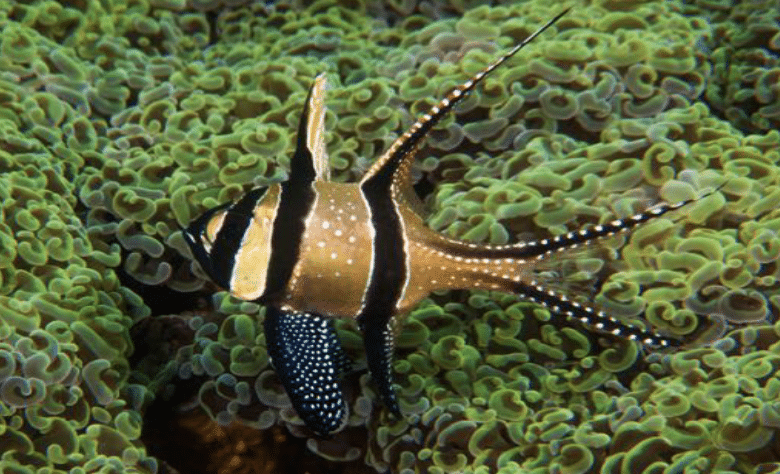
Banggai Cardinalfish
(Pterapogon kauderni)
This distinctive cardinalfish species is endemic to the Banggai Islands of Indonesia. It has a striking black body with white spots and is popular in the aquarium trade.
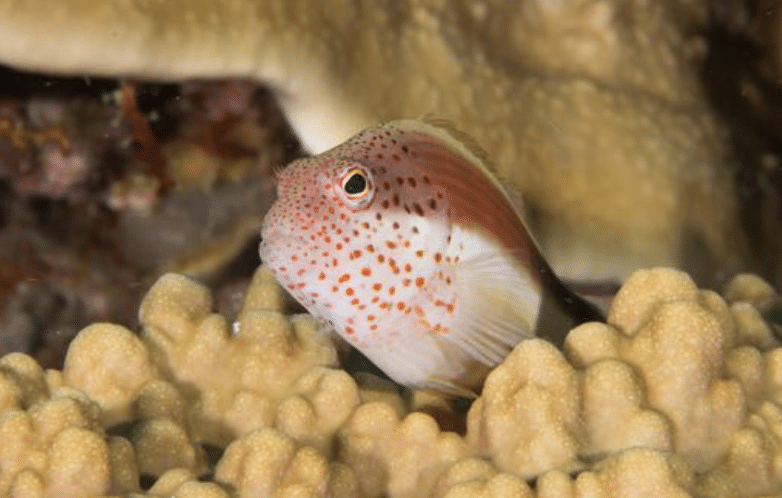
Freckled Hawkfish
(Paracirrhites forsteri)
The Freckled Hawkfish has a reddish-brown body adorned with small freckle-like spots. It inhabits coral reefs in the Indo-Pacific and is often seen perched on coral branches, waiting to ambush prey.
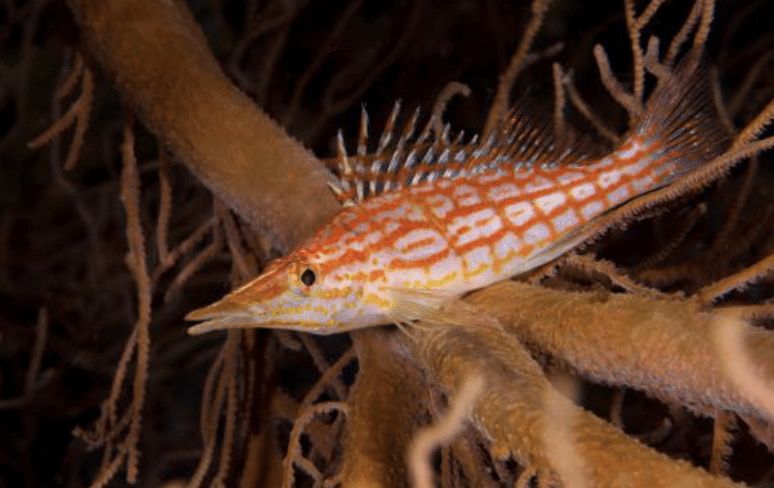
Longnose Hawkfish
(Oxycirrhites typus)
This hawkfish species is known for its elongated snout and vibrant red coloration. It prefers rocky areas and coral reefs with strong currents, where it perches on rocks and coral branches.
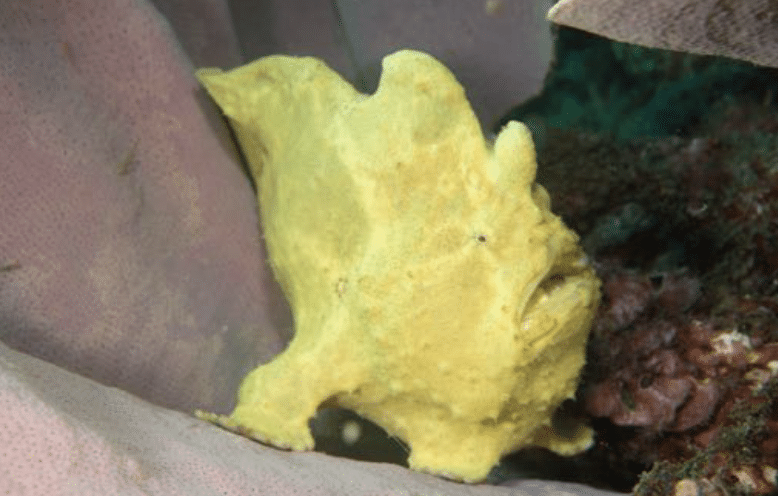
Painted Frogfish
(Antennarius pictus)
The Painted Frogfish is characterized by its mottled pattern of brown, white, and yellow colors, resembling a painted canvas. It’s a master of camouflage, blending seamlessly into its surroundings on coral reefs in the Indo-Pacific.
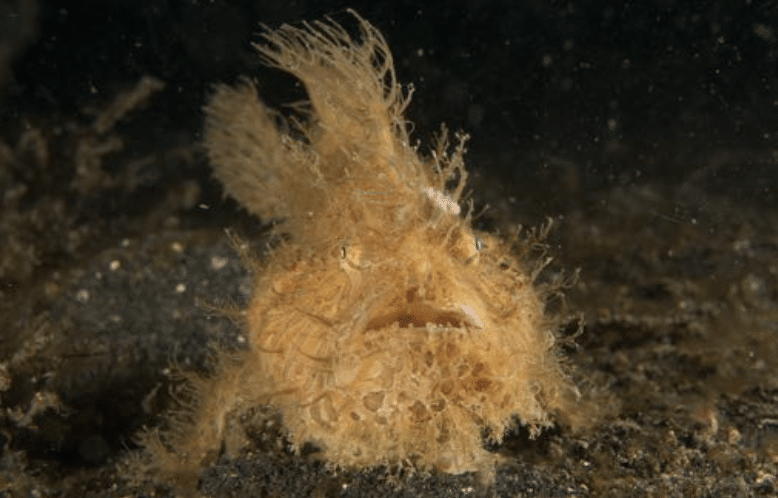
Hairy Frogfish
(Antennarius striatus)
As the name suggests, this frogfish species has numerous fleshy appendages resembling hair covering its body. It’s found in coral reefs and rocky areas, using its camouflage to ambush unsuspecting prey.
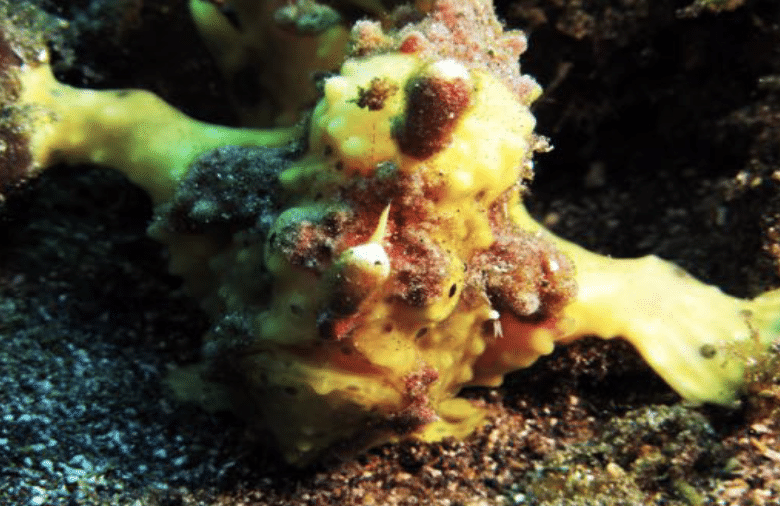
Warty Frogfish
(Antennarius maculatus)
The Warty Frogfish has a rough, warty appearance and can vary in color from brown to yellow or even white. It’s an ambush predator found in coral reefs and rocky habitats, relying on camouflage to capture prey.
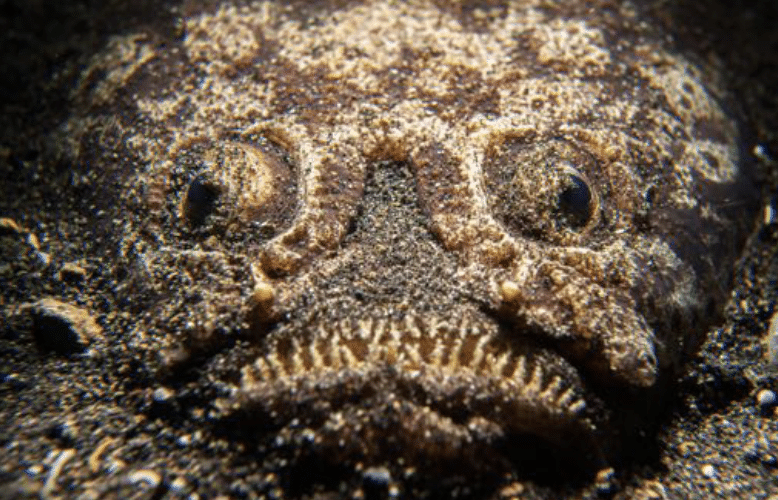
Reticulate Stargazer
(Uranoscopus sp)
Stargazers are known for their upward-facing eyes and large mouths. The Reticulate Stargazer likely has a patterned or reticulated appearance on its body, resembling its name. These fish bury themselves in sandy or muddy substrates and ambush prey as it passes by.
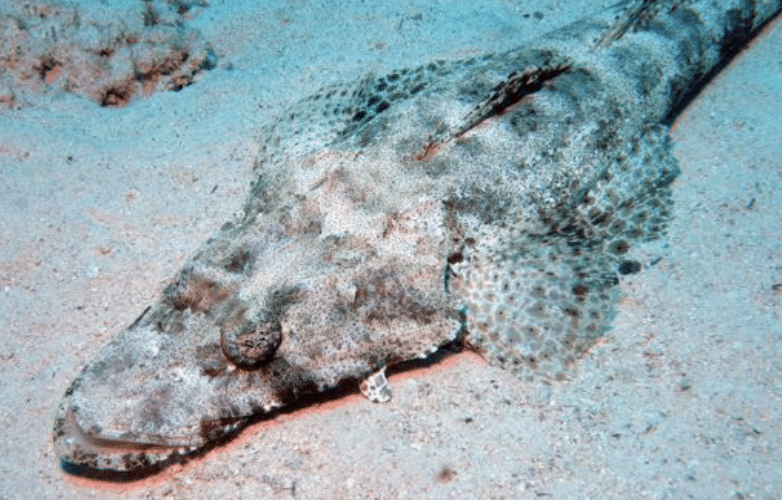
Crocodile Flathead
(Cociella crocodila )
The Crocodile Flathead is a species of flathead fish characterized by its elongated body and flattened head, resembling that of a crocodile. It inhabits sandy or muddy bottoms in coastal waters, where it camouflages itself to ambush prey.
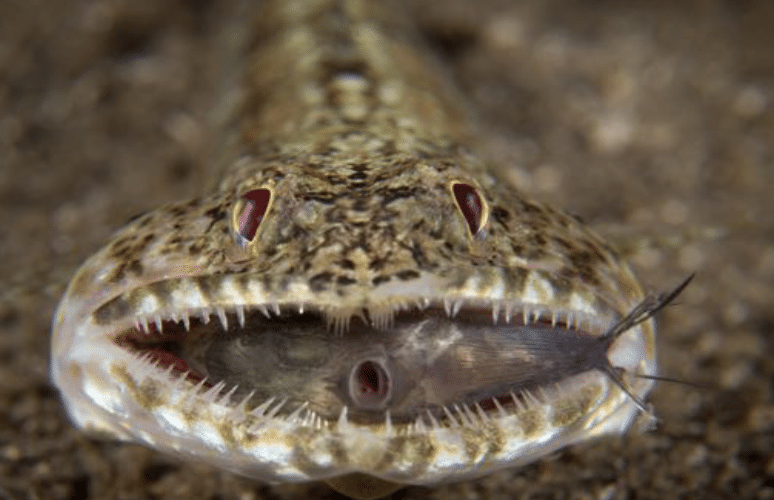
Shortfin Lizardfish
(Saurida umeyoshii)
This lizardfish species has a slender body with a long, lizard-like head and sharp teeth. It’s found in shallow coastal waters and coral reefs, lurking near the substrate to ambush small fish and crustaceans.
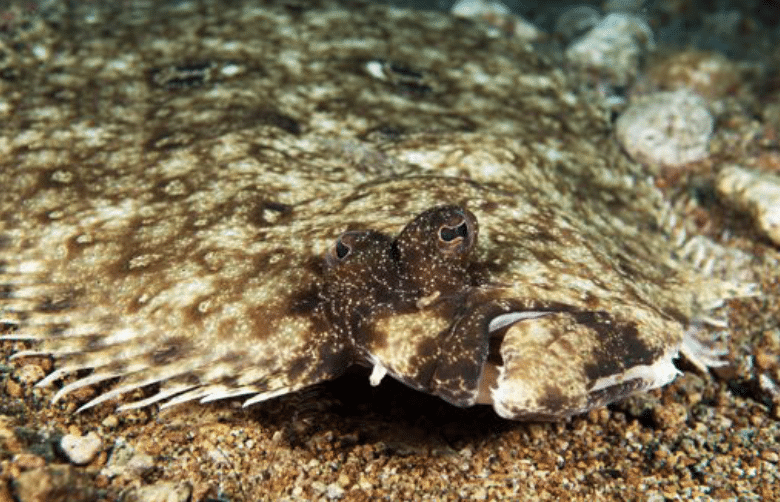
Largscale Flounder
(Engryposopon grandisquama)
The Largscale Flounder is a flatfish species with a distinctive scale pattern and asymmetrical body. It’s found in sandy or muddy bottoms in coastal waters, where it camouflages itself by burying in the substrate.
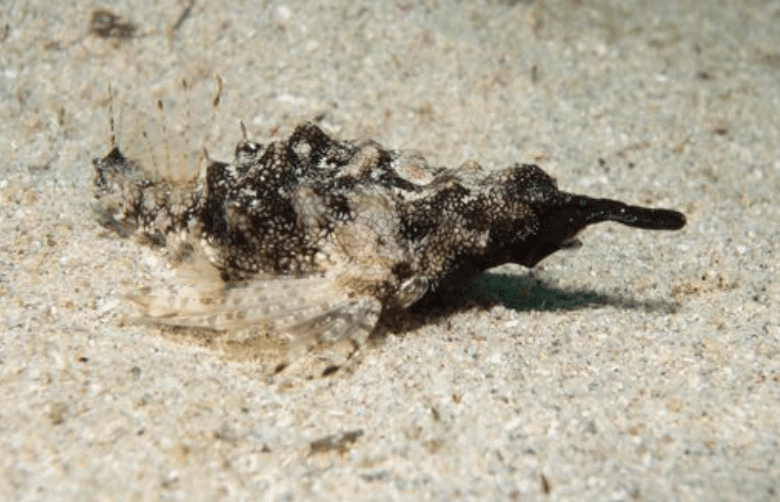
Pegasus Seamoth
(Eurypegasus draconis)
The Pegasus Seamoth is a fascinating fish with wing-like fins that resemble those of a mythical Pegasus. It inhabits sandy or muddy bottoms in shallow coastal waters, using its modified fins to “fly” through the water.
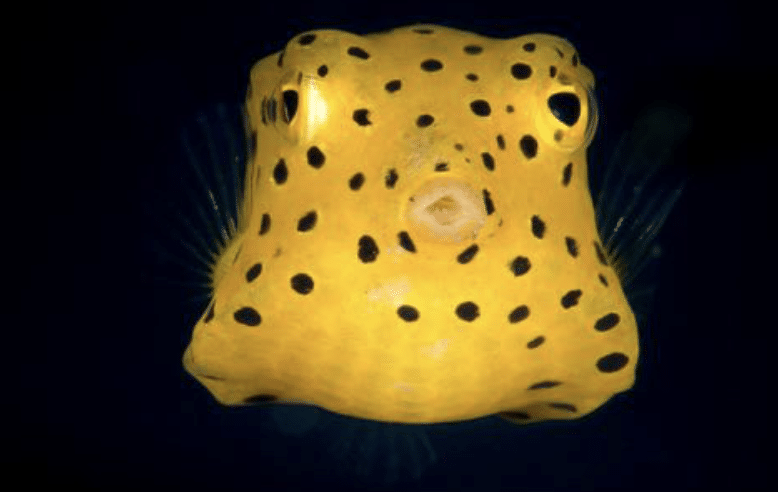
juv. Yellow Boxfish
(Ostracion cubicus)
As juveniles, Yellow Boxfish have a bright yellow coloration with black spots, resembling tiny boxes. They inhabit shallow coastal waters and reefs, where they feed on small invertebrates and algae.
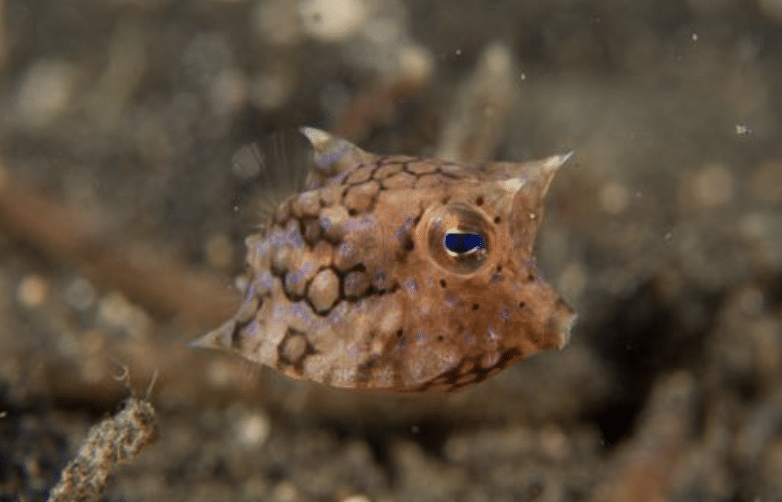
juv. Thornback Cowfish
(Lactoria fornasini)
Juvenile Thornback Cowfish have a rounded body covered in small thorn-like protrusions. They are commonly found in shallow waters near reefs, where they use their unique appearance as camouflage against predators.
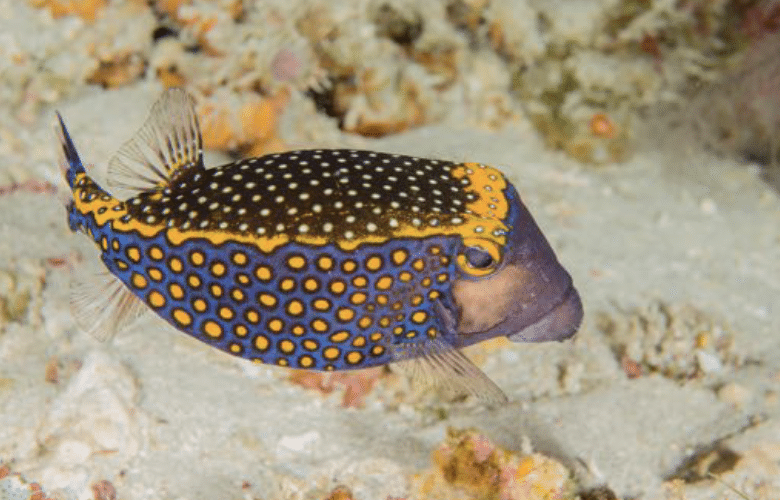
Spotted Boxfish
(Ostracion meleagris)
The Spotted Boxfish has a box-like body covered in small white spots against a dark background. It’s found in tropical waters near coral reefs, where it feeds on small invertebrates and algae.
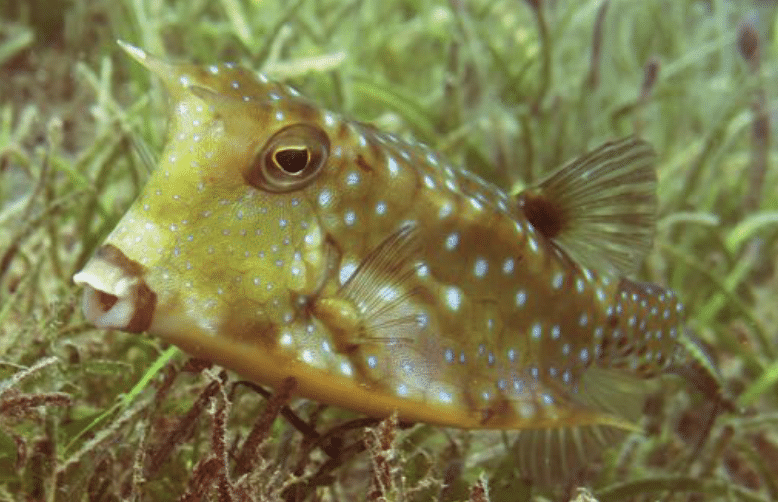
Longhorn Cowfish
(Lactoria cornuta)
This species of cowfish has elongated horns protruding from its head, giving it a distinctive appearance. It inhabits tropical reefs and lagoons, where it feeds on a variety of small invertebrates and algae.
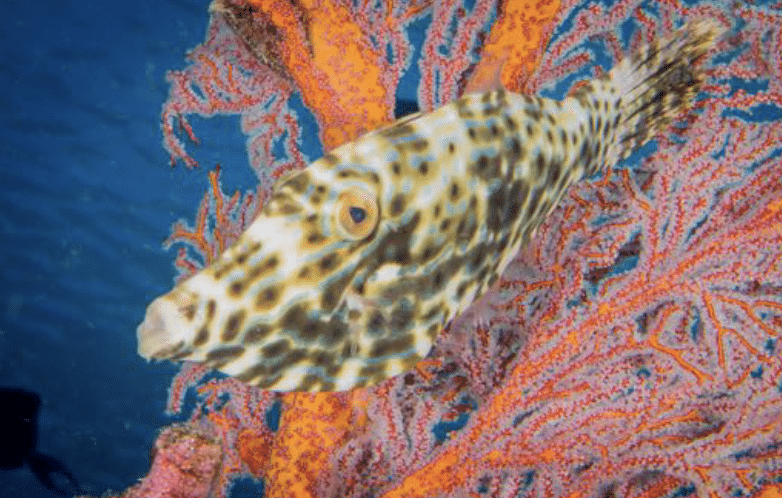
Scrawled Filefish
(Aluterus scriptus)
The Scrawled Filefish is named for the intricate scribbled patterns on its body. It’s found in tropical waters near reefs and seagrass beds, where it feeds on small invertebrates and algae.
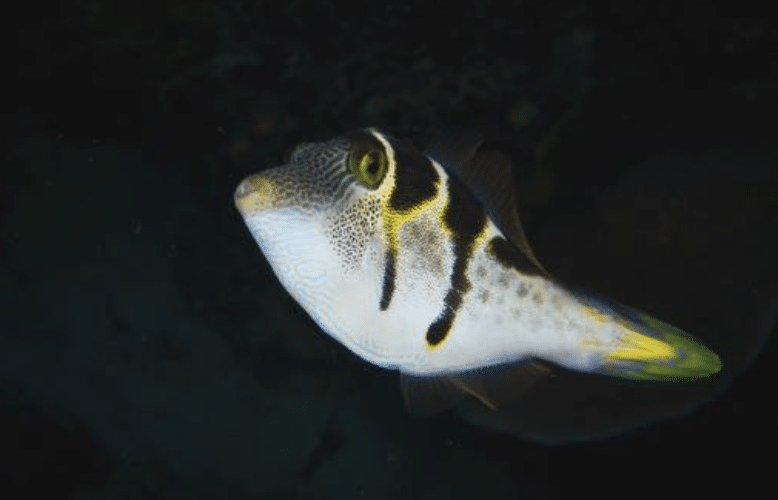
Mimic Filefish
(Paraluterus prionurus)
The Mimic Filefish is known for its ability to mimic the appearance of toxic flatworms for protection. It’s found in tropical waters near coral reefs, where it feeds on a variety of small invertebrates and algae.
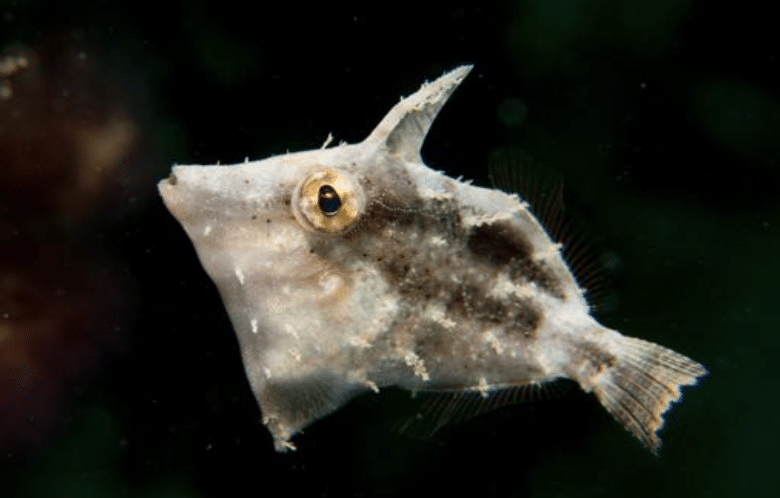
Whitebar filefish
(Paramonacanthus choirocephalus)
This filefish species has a white bar across its body, contrasting with its dark coloration. It’s found in tropical waters near coral reefs, where it feeds on small invertebrates and algae.
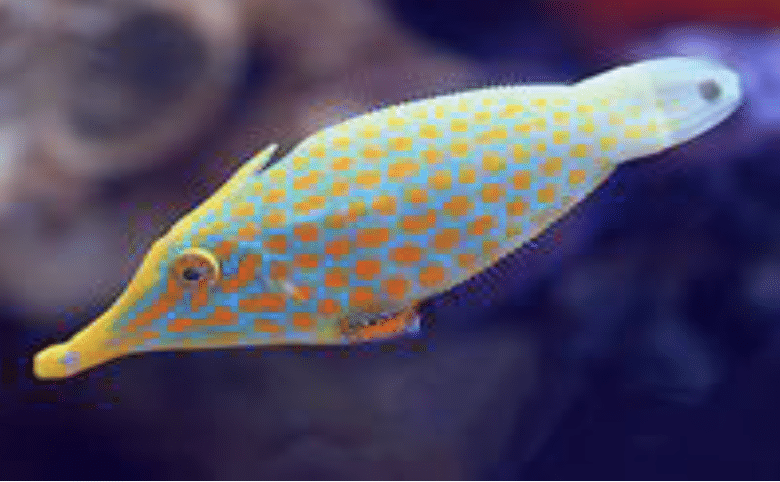
Longnose Filefish
(Oxymonocanthus longirostis)
The Longnose Filefish has an elongated snout and a laterally compressed body. It’s often found in tropical coral reef habitats, where it feeds on algae and small invertebrates.
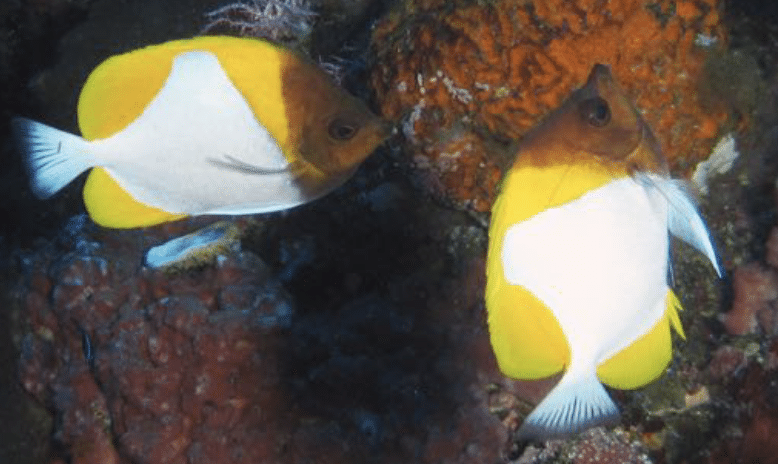
Pyramid Butterflyfish
(Hemitaurichthys polylepis)
This butterflyfish species has a triangular-shaped body with a vibrant yellow color and black bands. It inhabits coral reefs in the Indo-Pacific region, often forming large schools.
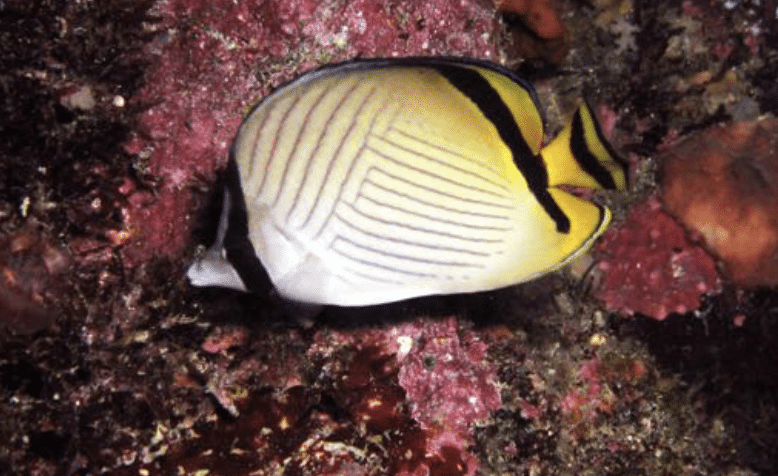
Vagabond Butterflyfish
(Chaetodon vagabundus)
The Vagabond Butterflyfish has a white body with diagonal yellow stripes and a black eye mask. It’s found in tropical waters of the Indo-Pacific and feeds on coral polyps and small invertebrates.
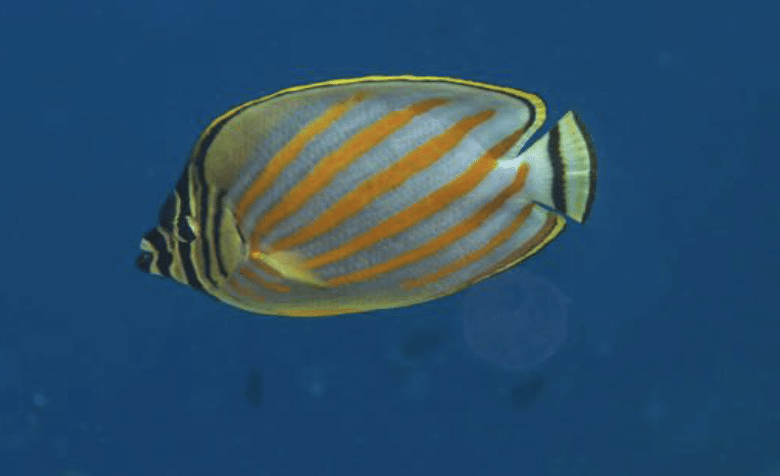
Ornate Butterflyfish
(Chaetodon ornatissimus)
This butterflyfish species is known for its intricate black and yellow patterning, resembling delicate lace. It’s found in coral-rich areas of the Indo-Pacific and feeds primarily on coral polyps.
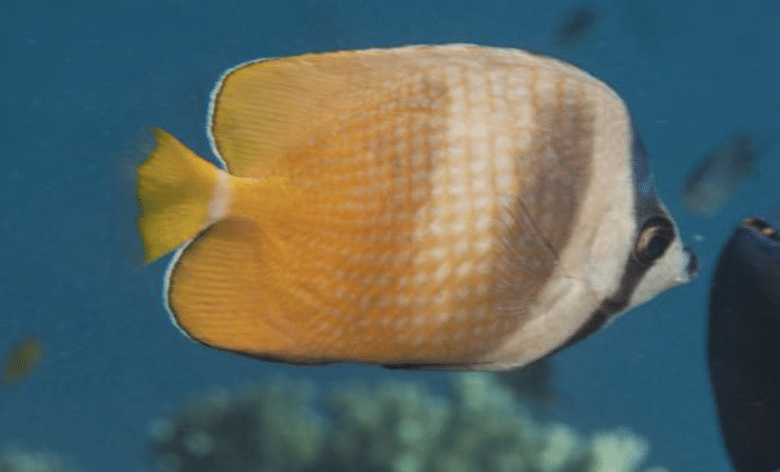
Blacklip Butterflyfish
(Chaetodon kleinii)
The Blacklip Butterflyfish has a predominantly yellow body with a distinctive black stripe running through its eye and a black patch on its lower lip. It’s found in coral reefs throughout the Indo-Pacific and feeds on coral polyps and small invertebrates.
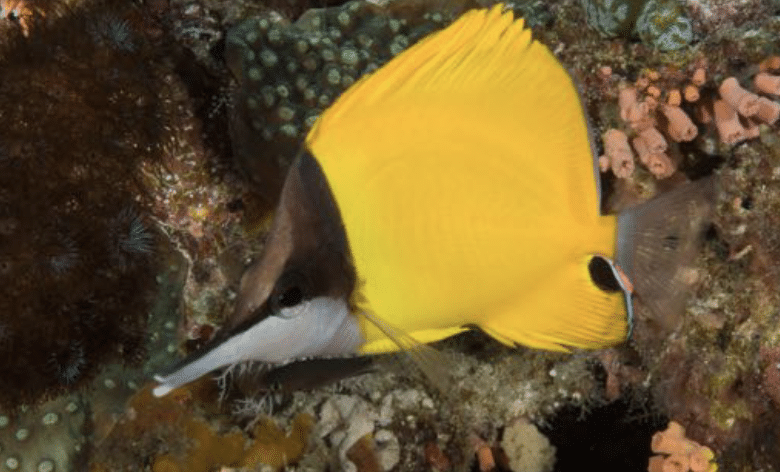
Long-nose Butterflyfish
(Forcipiger flavissimus)
As the name suggests, this butterflyfish species has an elongated snout. It has a yellow body with black markings and is found in coral reefs of the Indo-Pacific, feeding on small invertebrates and coral polyps.
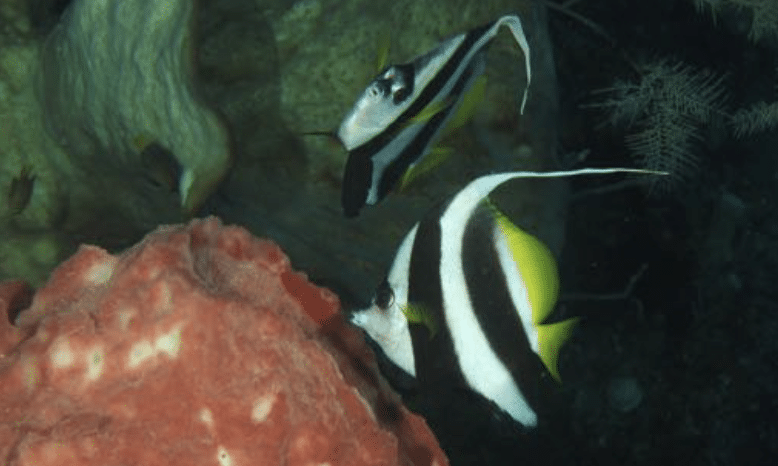
Longfin Bannerfish
(Heniochus acuminatus)
The Longfin Bannerfish has elongated dorsal and anal fins, giving it a distinctive appearance. It’s found in tropical waters of the Indo-Pacific and forms schools near coral reefs, feeding on planktonic organisms.
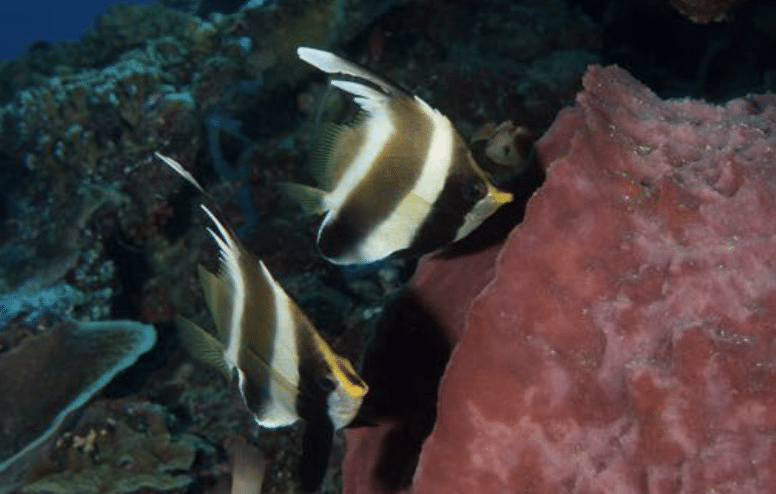
Pennant Bannerfish
(Heniochus chrysostomus)
his bannerfish species has a deep body with long, trailing dorsal and anal fins resembling pennants. It’s found in coral reefs of the Indo-Pacific and feeds on zooplankton and small invertebrates.
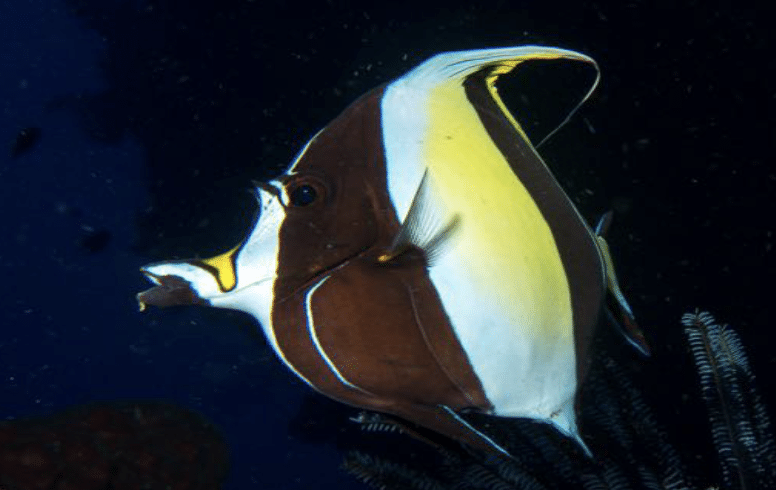
Moorish Idol
(Zanclus cornutus)
The Moorish Idol is characterized by its distinctive black, white, and yellow striped body and elongated dorsal fin. It’s found in tropical waters of the Indo-Pacific and is often seen in pairs or small groups near coral reefs.
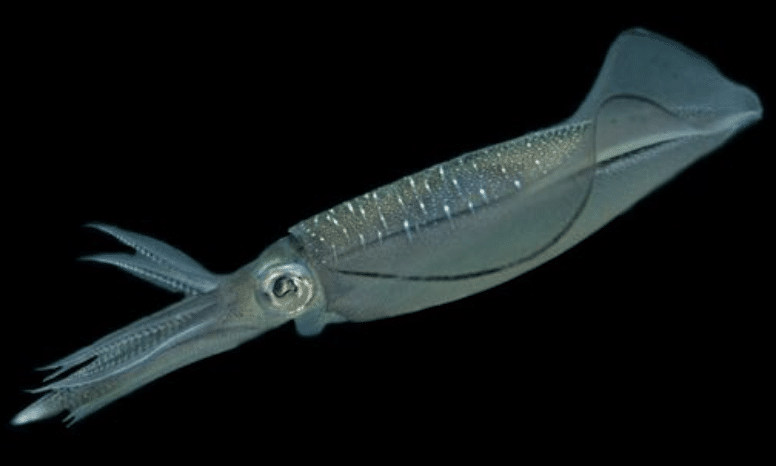
Bigfin Reef Squid
(Sepiotheutis lessoniana)
The Bigfin Reef Squid has a streamlined body with large fins and can vary in color from reddish-brown to white. It’s found in coastal waters and coral reefs throughout the Indo-Pacific, where it hunts small fish and crustaceans.
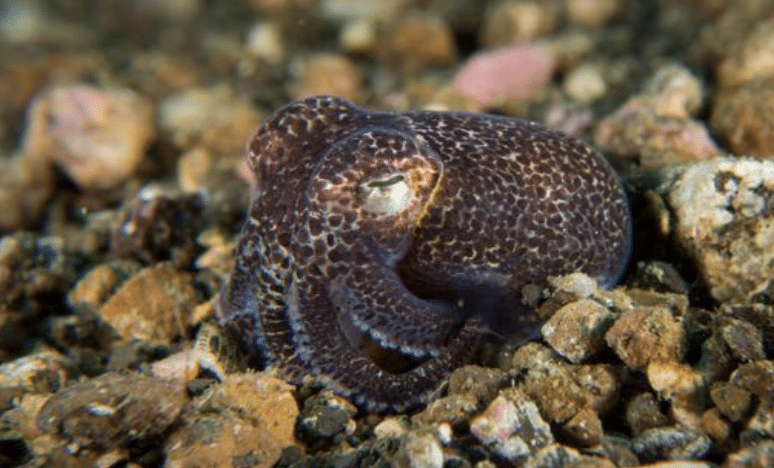
Berry’s Bobtail Squid
(Euprymna berryi)
Berry’s Bobtail Squid is a small, nocturnal squid species found in shallow coastal waters. It has a rounded body and distinctive chromatophores that allow it to change color for camouflage. It feeds on small crustaceans and fish.
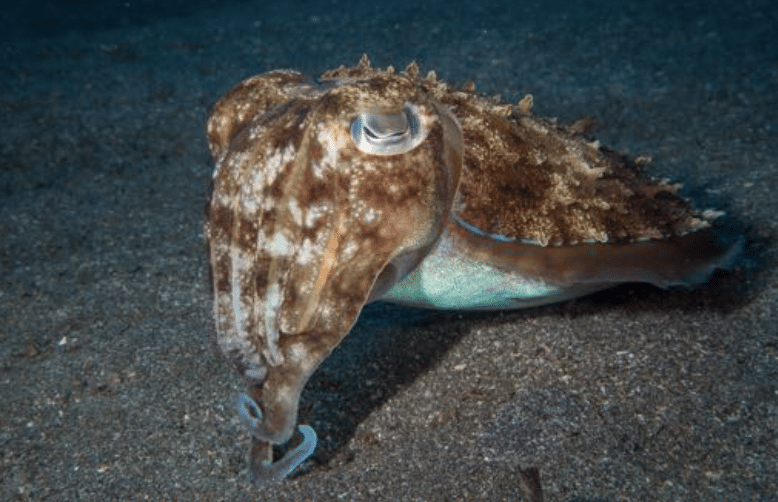
Broad Club Cuttlefish
(Sepia latimanus)
The Broad Club Cuttlefish is a species of cuttlefish characterized by its broad body and distinctive club-shaped fins. It’s found in tropical waters of the Indo-Pacific and is known for its ability to change color and texture for camouflage and communication.
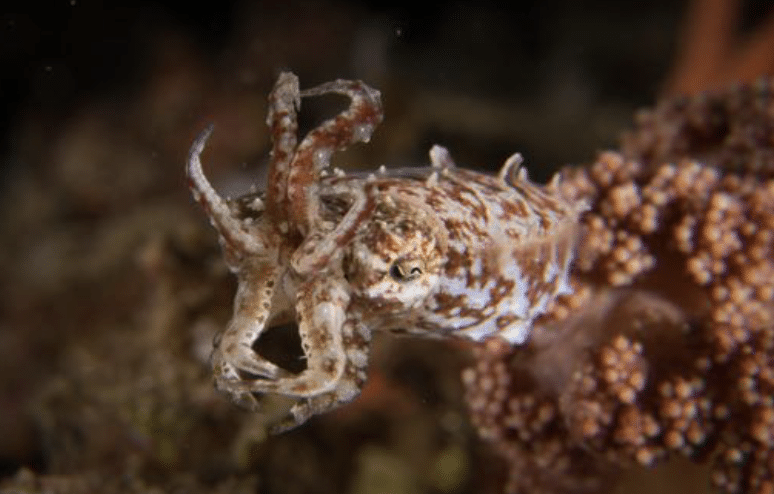
Pygmy Cuttlefish
(Sepia bandensis)
The Pygmy Cuttlefish is one of the smallest species of cuttlefish, typically measuring only a few inches in length. Despite their small size, they exhibit complex behaviors and can change color rapidly. They’re found in shallow coastal waters of the Indo-Pacific.
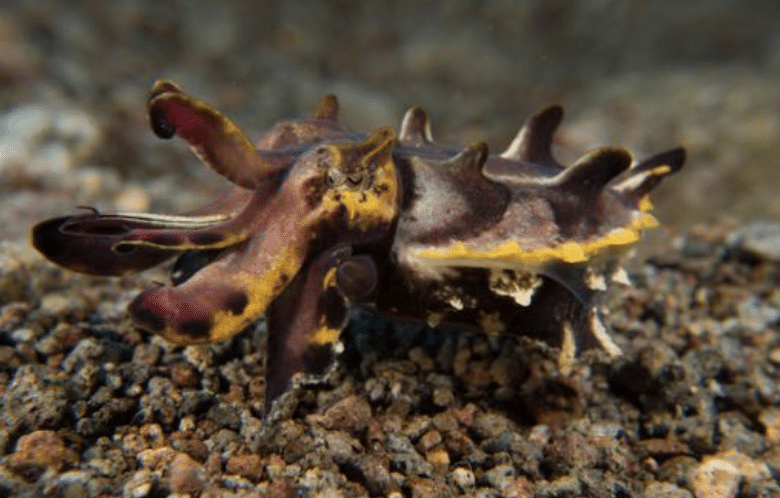
Flamboyant Cuttlefish
(Metasepia pfefferi)
The Flamboyant Cuttlefish is renowned for its vibrant coloration and unique walking behavior on the seafloor. It’s found in shallow waters of the Indo-Pacific and possesses toxic flesh, making it unpalatable to predators.
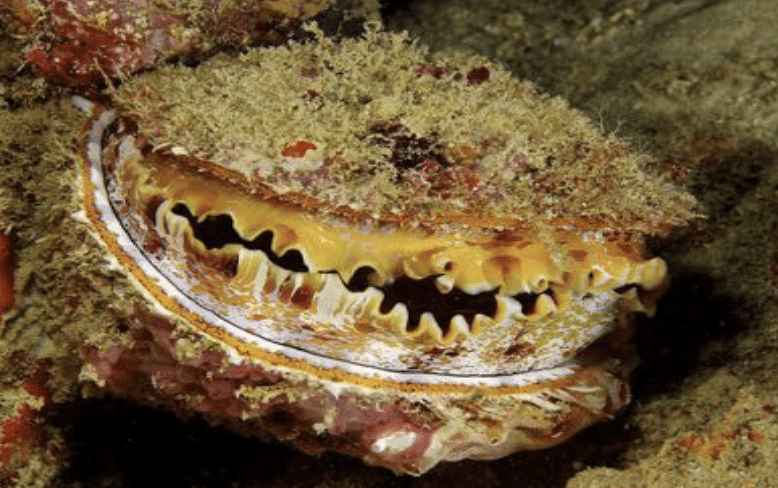
Thorny Oyster
(Spondylus varians)
The Thorny Oyster is a bivalve mollusk characterized by its rough, spiny exterior. It attaches itself to hard substrates such as coral reefs or rocks and filters plankton from the water for nutrition.
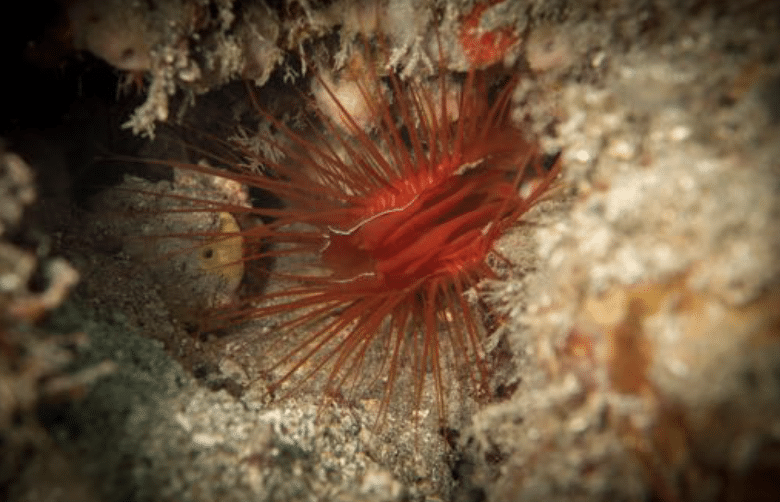
Electric Clam
(Ctenoides ales)
The Electric Clam, also known as the Disco Clam, has a vibrant, iridescent mantle that flashes light, creating a disco-like effect. It’s found in tropical coral reefs of the Indo-Pacific and is thought to use its light display to deter predators.
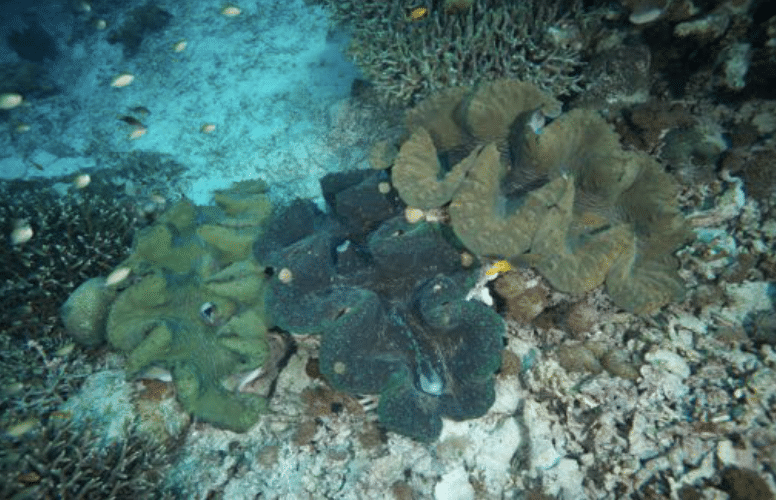
Giant Clam
(Tridacna gigas)
The Giant Clam is one of the largest species of bivalve mollusks, with some individuals reaching several feet in length. It inhabits shallow coral reef habitats and forms a symbiotic relationship with photosynthetic algae, which provides it with nutrients.
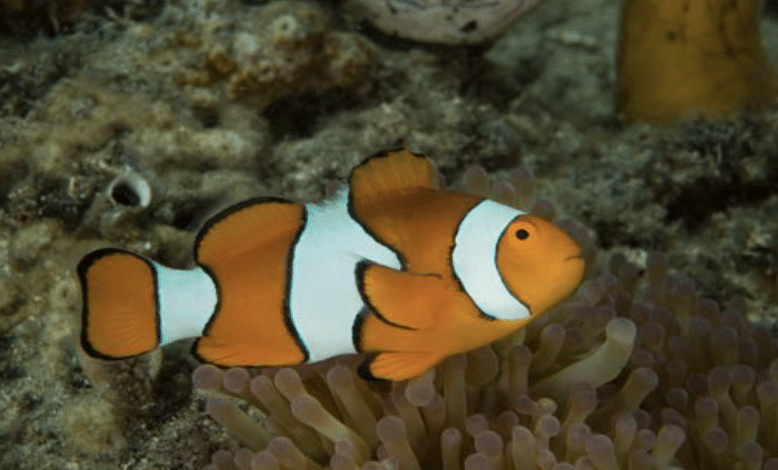
Clown Anemonefish
(Amphiprion percula)
The Clown Anemonefish, also known as the Percula Clownfish, is characterized by its bright orange body with three white stripes outlined in black. It forms a mutualistic relationship with sea anemones, using them for protection from predators.
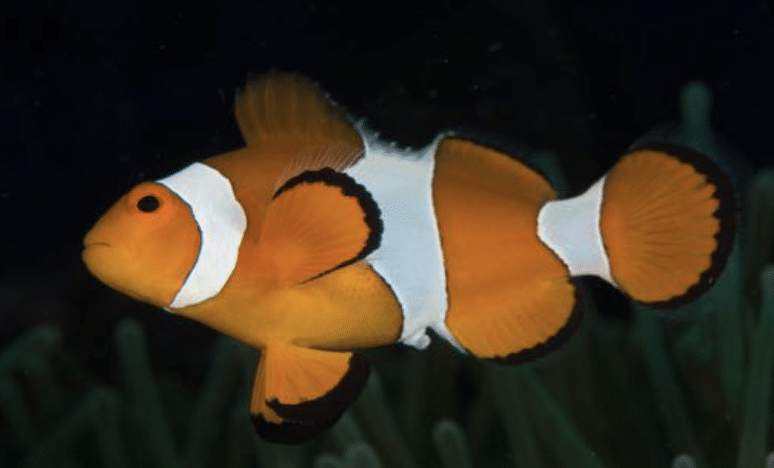
False Clown Anemonefish
(Amphiprion ocellaris)
Similar in appearance to the Clown Anemonefish, the False Clown Anemonefish has a more extensive black margin on its white stripes. It also forms symbiotic relationships with sea anemones in tropical reef environments.
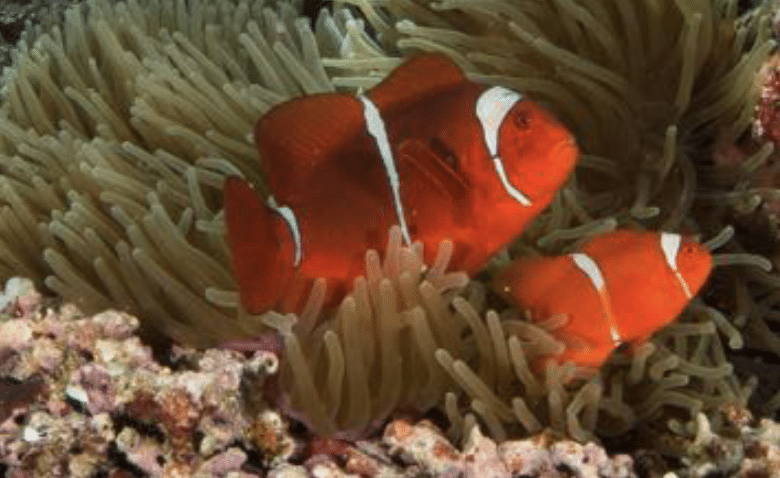
Spinecheeck Anemonefish
(Premnas biaculeatus)
The Spinecheek Anemonefish is distinguished by its orange body with a single white stripe and a prominent spine on each cheek. Like other anemonefish, it forms associations with sea anemones for protection.
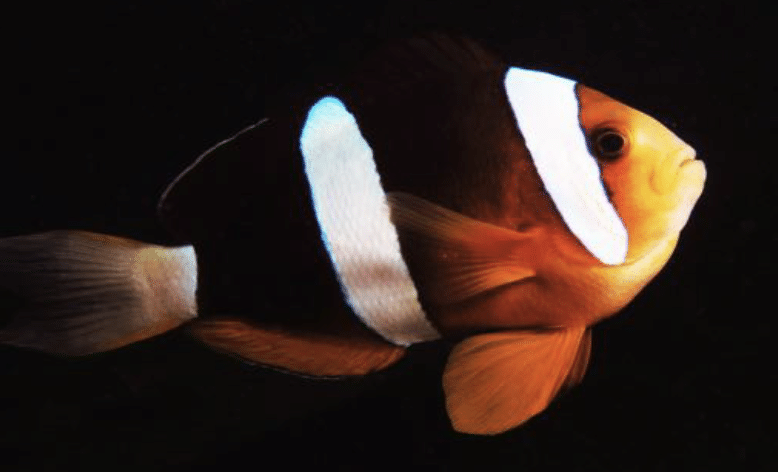
Clark’s Anemonefish
(Amphiprion clarkii)
Clark’s Anemonefish has a yellow-orange body with white stripes, and it typically inhabits the Indo-Pacific region. It forms symbiotic relationships with various species of sea anemones, which provide it with protection from predators.
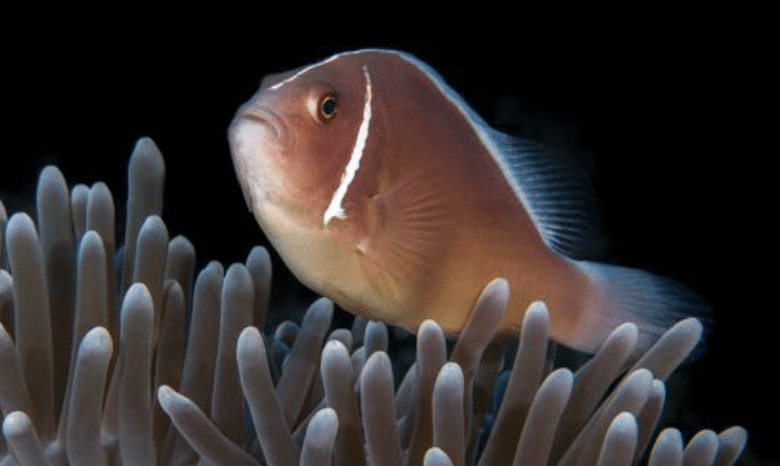
Pink Anemonefish
(Amphiprion perideraion)
The Pink Anemonefish has a pinkish-orange body with white stripes. It forms symbiotic relationships with sea anemones, where it seeks refuge and protection from predators.
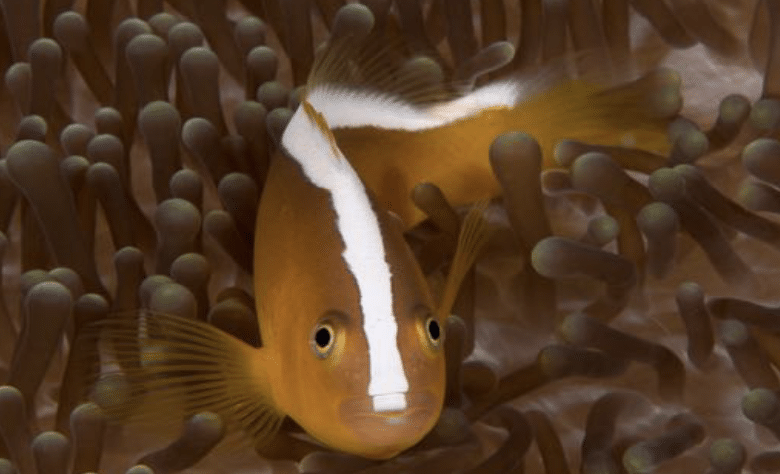
Orange Anemonefish
(Amphiprion sandaracinos)
The Orange Anemonefish, as the name suggests, has a predominantly orange body with white stripes. It’s found in coral reefs of the Indo-Pacific and forms symbiotic relationships with sea anemones for protection.
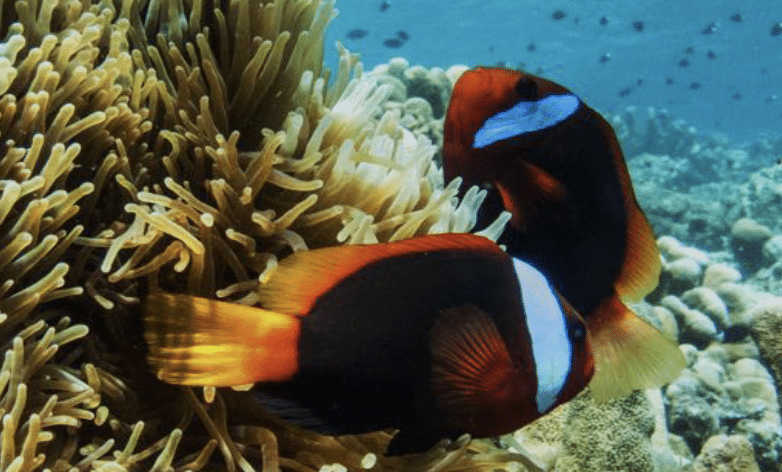
Tomato Anemonefish
(Amphiprion frenatus)
The Tomato Anemonefish is named for its vibrant red-orange coloration resembling a ripe tomato. It forms symbiotic relationships with sea anemones in coral reef habitats, where it seeks refuge and protection.
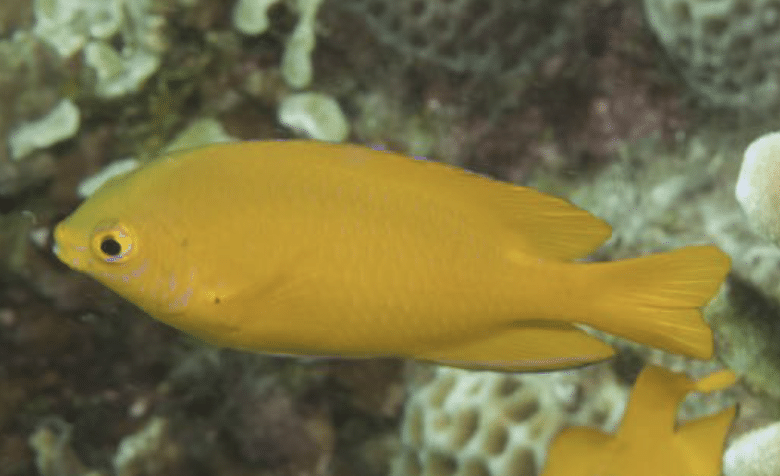
Ambon Damsel
(Pomacentrus amboinensis)
The Ambon Damsel, also known as the Blue Damselfish, is a small, brightly colored fish commonly found in coral reef environments. It often forms schools and feeds on plankton and small invertebrates.
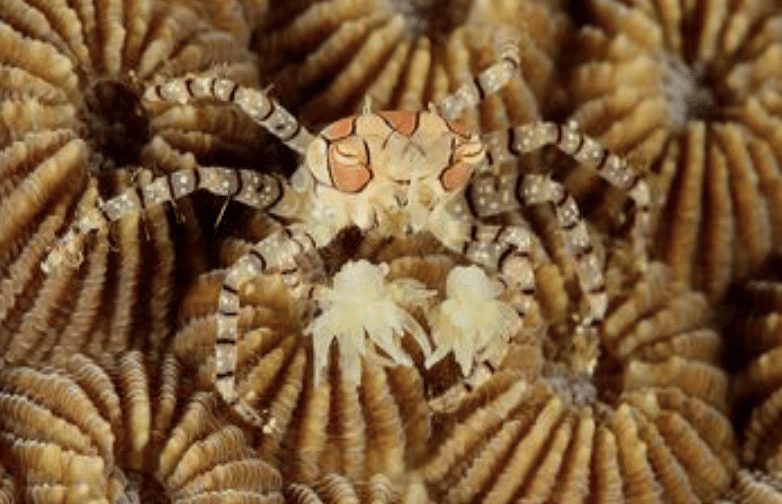
Boxer Crab
(Lybia tessellata)
The Boxer Crab, also known as the Pom-Pom Crab, carries small sea anemones in its claws for defense. It’s often found in sandy or rocky substrates in tropical waters, where it scavenges for food.
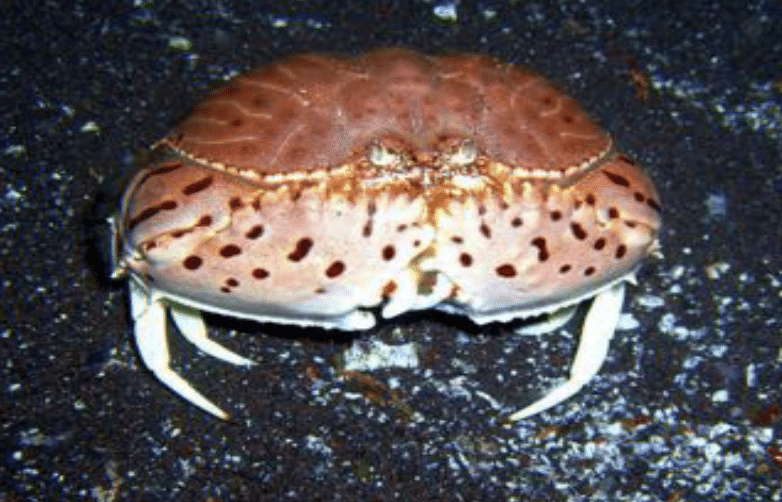
Box Crab
(Calappa lophos)
The Box Crab has a square-shaped body with large, flattened claws. It’s typically found in sandy or muddy bottoms of shallow tropical waters, where it feeds on small invertebrates.
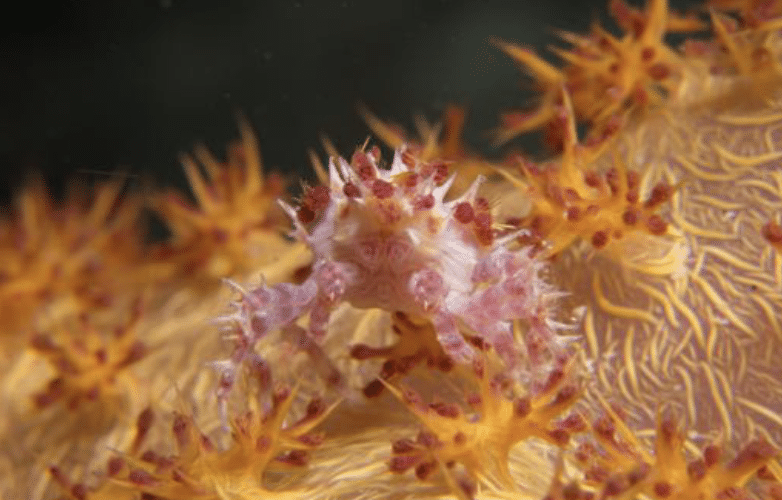
Candy Crab
(Hoplophrys oatesi)
The Candy Crab is named for its vibrant pink and white coloration, resembling candy. It’s often found camouflaged among soft corals in tropical reef environments.
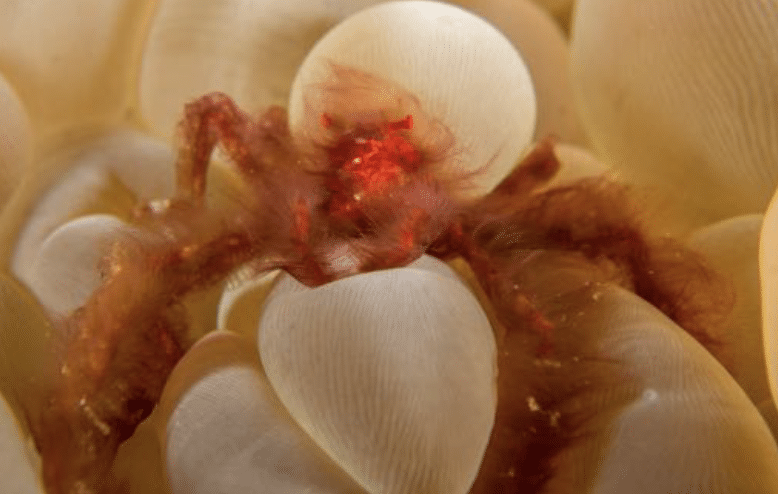
Orang-utan Crab
(Achaeus japonicus)
The Orang-utan Crab has long, hairy claws resembling the fur of an orangutan. It’s found in coral reef habitats, where it feeds on small invertebrates and algae.
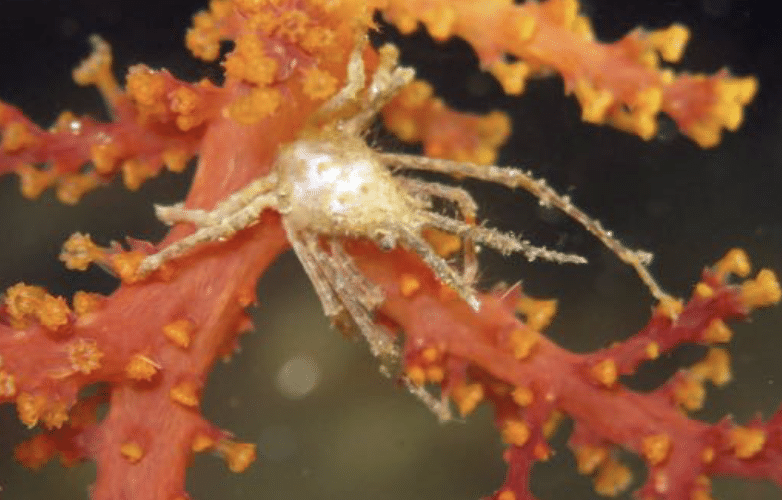
Bull Crab
(Naxioides taurus)
The Bull Crab is a large crab species with a robust body and powerful claws. It’s found in sandy or muddy substrates in tropical waters, where it scavenges for food.
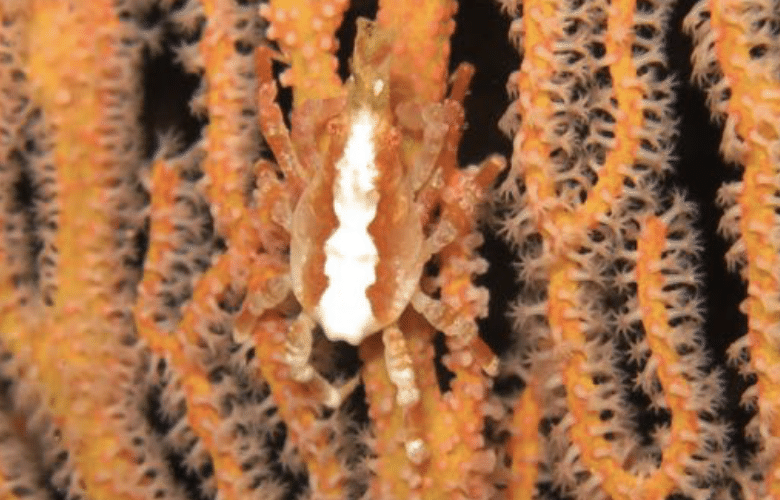
Conical Spider Crab
(Xenocarcinus conicus)
The Conical Spider Crab has a conical-shaped carapace with long, slender legs. It’s found in deep-sea environments, where it scavenges for food on the seafloor.
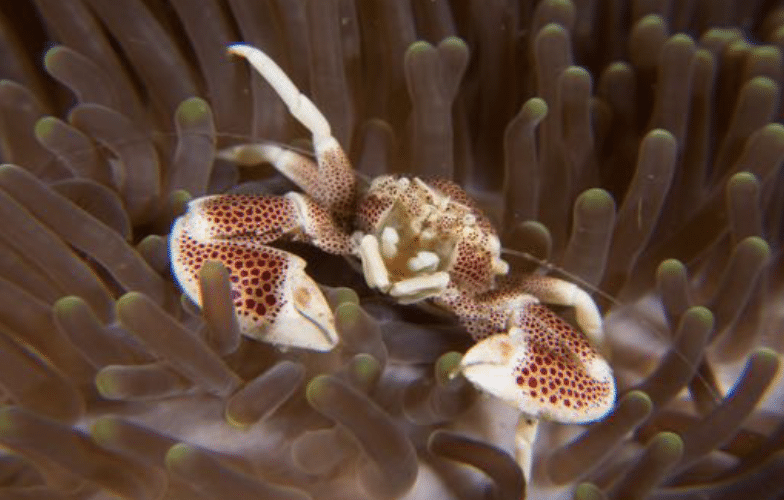
Spotted Porcelain Crab
(Neopetrolisthes maculatus)
The Spotted Porcelain Crab has a white body with red spots and long, delicate claws. It’s often found living in association with sea anemones or other cnidarians in coral reef habitats.
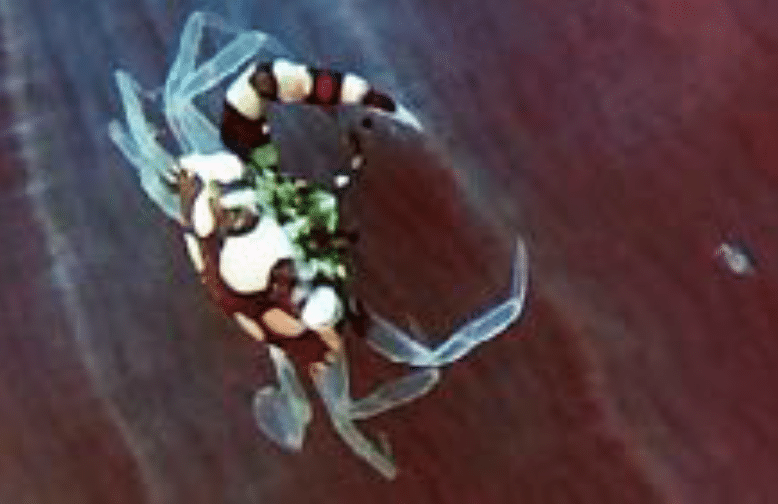
Harlequin Swimming Crab
(Lissocarcinus laevis)
The Harlequin Swimming Crab has a colorful pattern resembling that of a harlequin costume. It’s found in shallow waters near coral reefs, where it scavenges for food and hides among rocks and crevices.
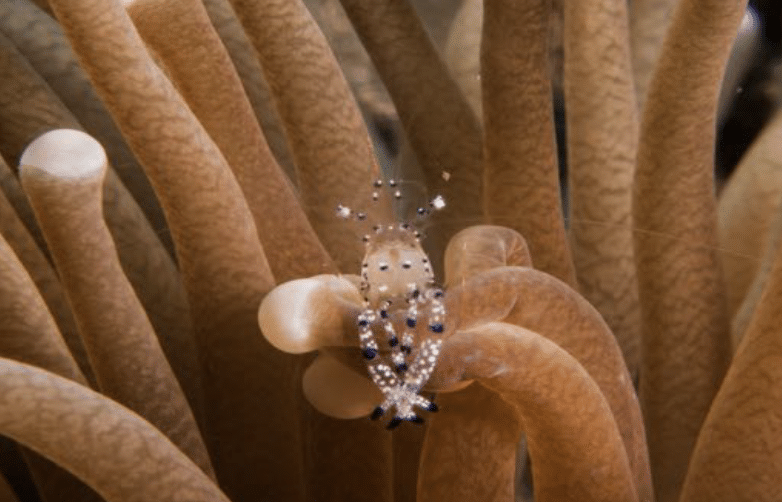
Anemone Shrimp
(Ancylomenes venustus)
The Anemone Shrimp is a small, shrimp-like crustacean that lives in symbiosis with sea anemones. It’s often found in tropical coral reef environments, where it helps clean the anemone’s tentacles and feeds on leftover food.
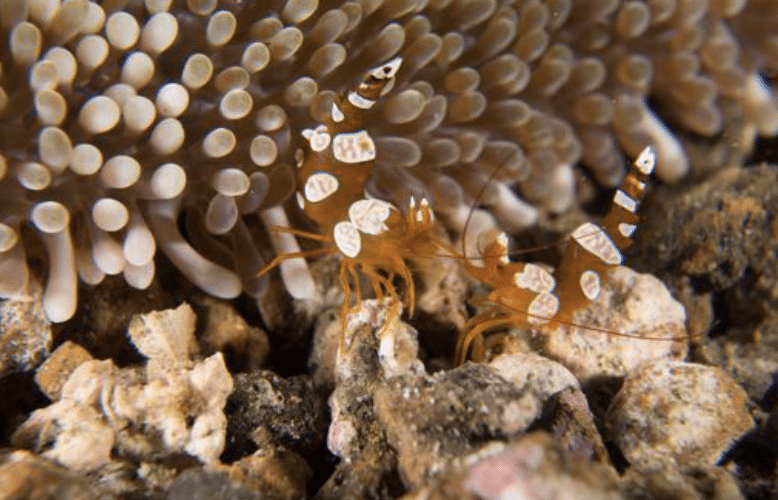
Squat Shrimp
(Thor amboinensis)
The Squat Shrimp, also known as the Sexy Shrimp, is a small, colorful shrimp species often found in association with sea anemones. It has a distinctive red and white body with long antennae and is commonly kept in reef aquariums.
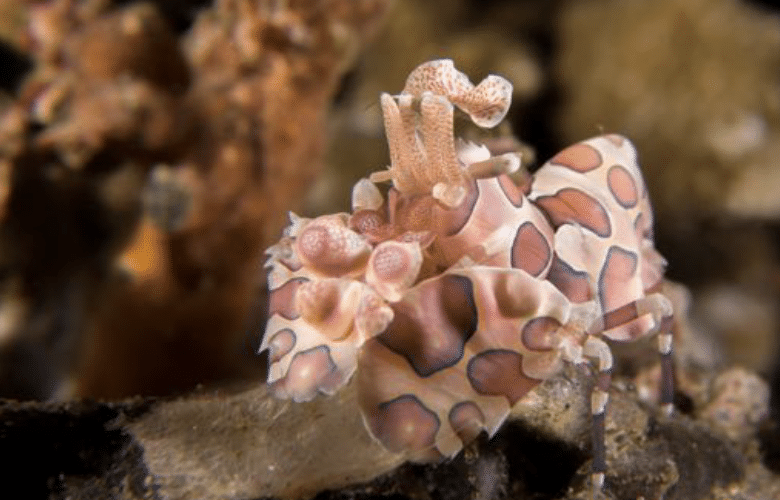
Harlequin Shrimp
(Hymenocera elegans)
The Harlequin Shrimp is named for its vibrant coloration and distinctive pattern resembling a harlequin costume. It’s a predatory shrimp species that feeds exclusively on starfish, using its powerful claws to dismantle its prey.
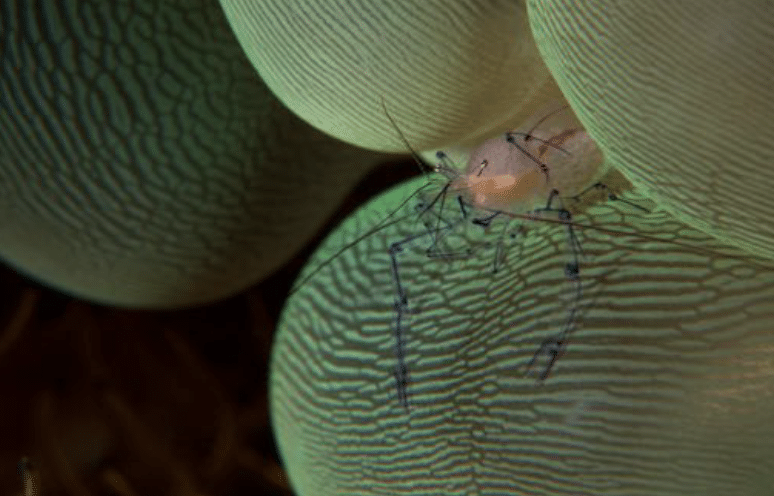
Bubble Coral Shrimp
(Vir philippinensis)
The Bubble Coral Shrimp is a small, cryptic shrimp species often found living among the branches of bubble corals. It has a translucent body with red and white markings and feeds on small planktonic organisms.
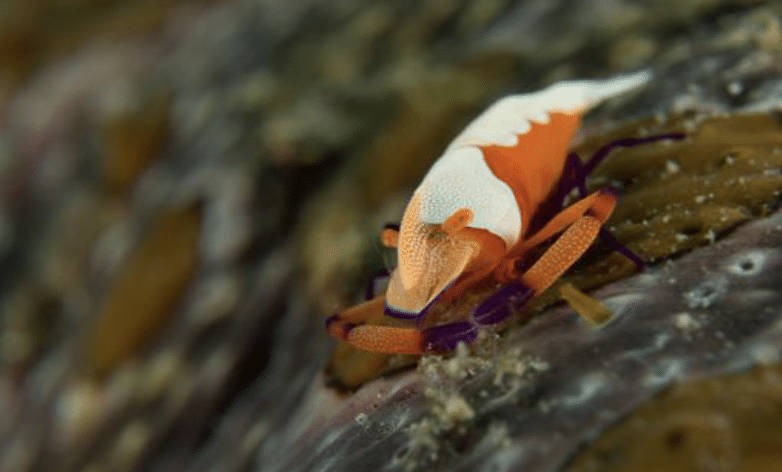
Emperor Shrimp
(Periclimenes imperator)
The Emperor Shrimp is known for its striking coloration, featuring bright purple and orange bands on its body. It’s commonly found in association with sea cucumbers and feeds on parasites and debris found on their skin.
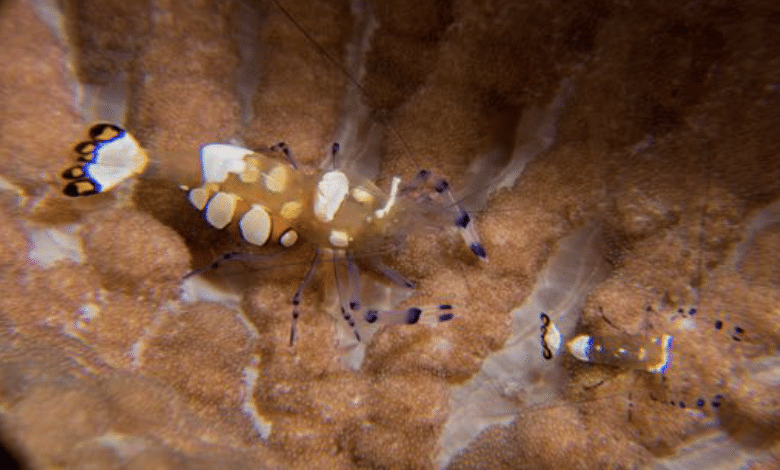
Peacock-Tail Anemone Shrimp
(Periclimenes brevicarpalis)
The Peacock-Tail Anemone Shrimp has a transparent body with vibrant blue and green stripes, resembling the tail feathers of a peacock. It lives in association with sea anemones, where it helps clean and maintain their tentacles.
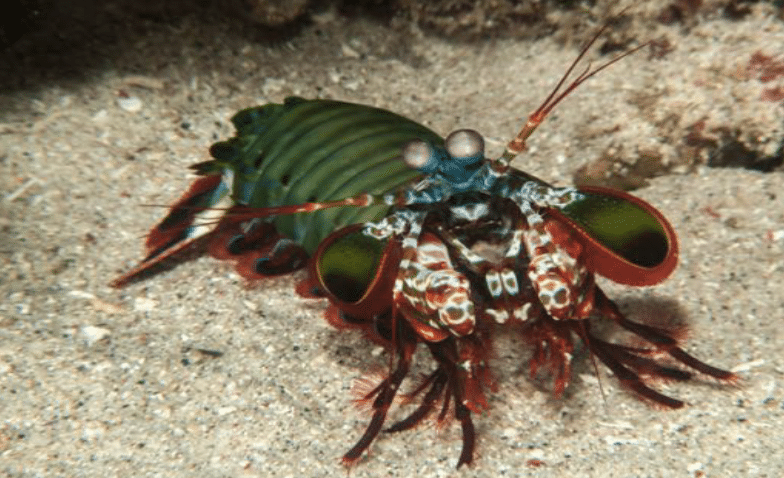
Peacock Mantis Shrimp
(Odontodactylus scyllarus)
The Peacock Mantis Shrimp is a strikingly colorful and highly predatory crustacean known for its powerful claw strikes. It has a brightly colored body with iridescent markings and is capable of breaking through hard-shelled prey with incredible force.
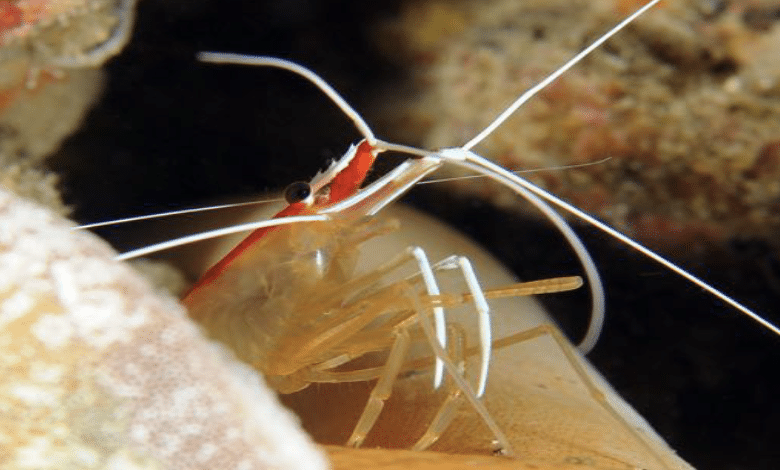
White Banded Cleaner Shrimp
(Lysmata amboinensis)
The White Banded Cleaner Shrimp has a white body with red bands and long, slender antennae. It’s commonly found in coral reef environments, where it acts as a cleaner organism, removing parasites and dead tissue from other fish.
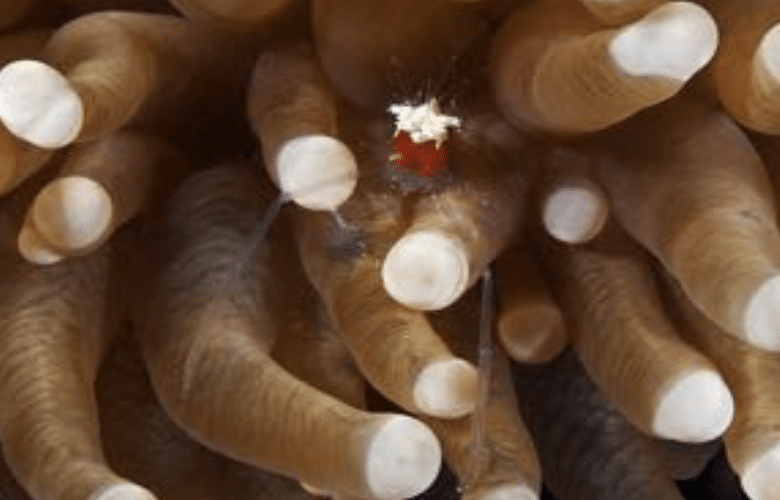
Popcorn Shrimp
(Lybia tessellata)
The Popcorn Shrimp, also known as the Boxer Crab, is a small shrimp species that carries small sea anemones in its claws for protection. It has a tan body with small white spots and is often found in sandy or rocky substrates.
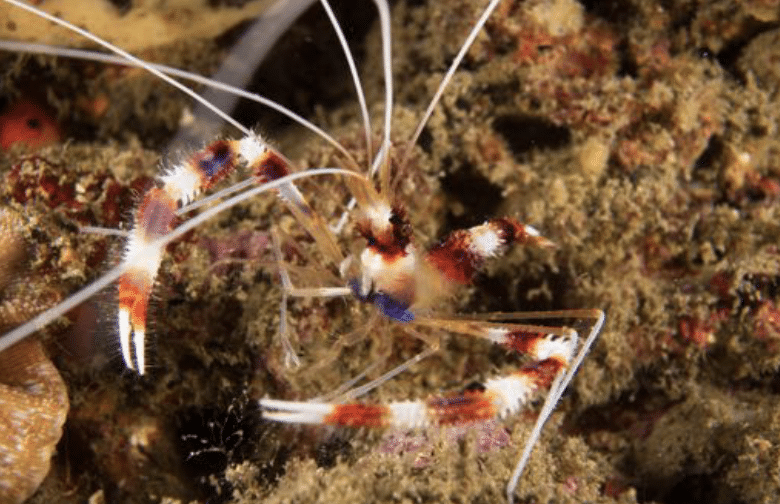
Banded Coral Shrimp
(Stenopus hispidus)
The Banded Coral Shrimp has a red and white striped body with long antennae and prominent claws. It’s commonly found in coral reef habitats, where it scavenges for food and acts as a cleaner organism for other fish.
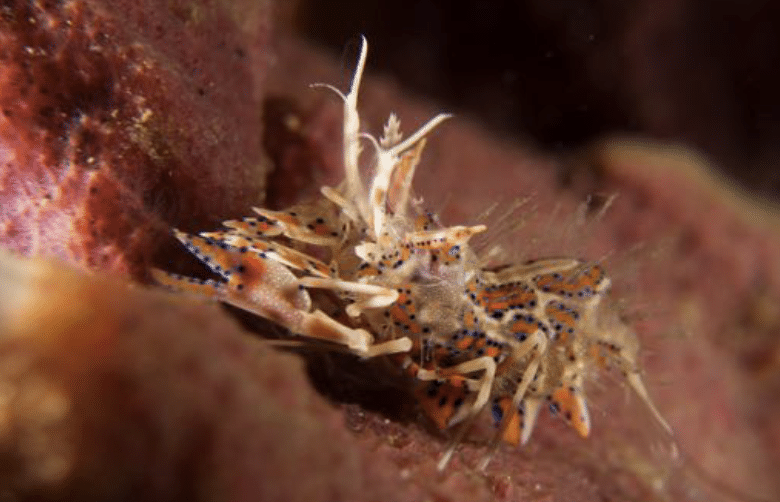
Tiger Shrimp
(Phyllognathia ceratophthalmus)
The Tiger Shrimp has a striking orange and black striped body resembling that of a tiger. It’s found in tropical waters, often hiding among coral rubble or algae beds.
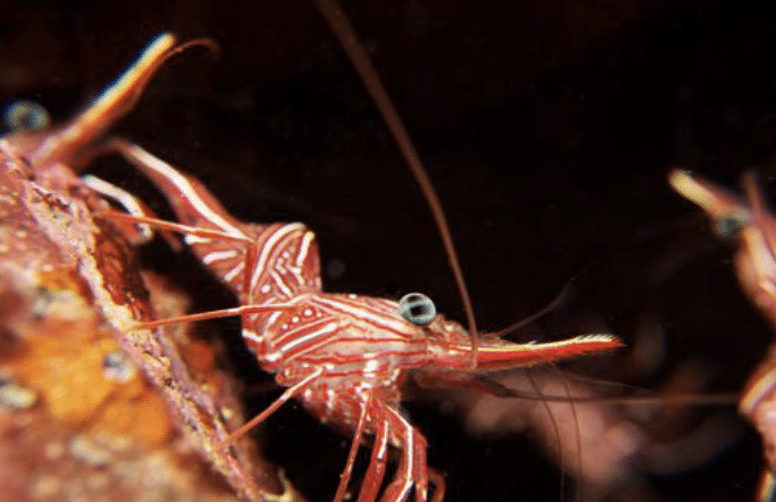
Dancing Shrimp
(Rhynchocinetes durbanensis)
The Dancing Shrimp has a translucent body with red and white markings and long, slender antennae. It’s commonly found in coral reef environments, where it scavenges for food and helps clean other organisms.
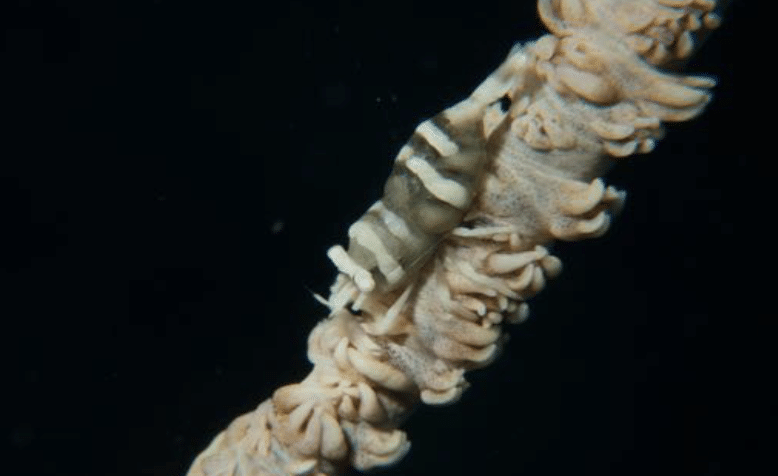
Anker’s Whip Coral Schrimp
(Pontonides ankeri)
Anker’s Whip Coral Shrimp is a small shrimp species that lives in association with whip corals. It has a transparent body with red and white bands and is often seen swaying with the motion of the coral it inhabits.
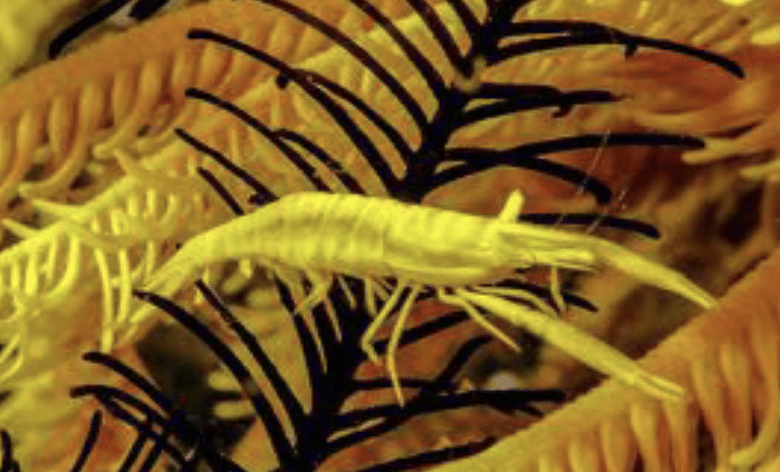
Slender Crinoid Shrimp
(Araiopontonia odontohyncha)
The Slender Crinoid Shrimp is a small shrimp species often found living among feather stars (crinoids). It has a slender body and long, delicate appendages, which it uses to navigate through the arms of the crinoid.
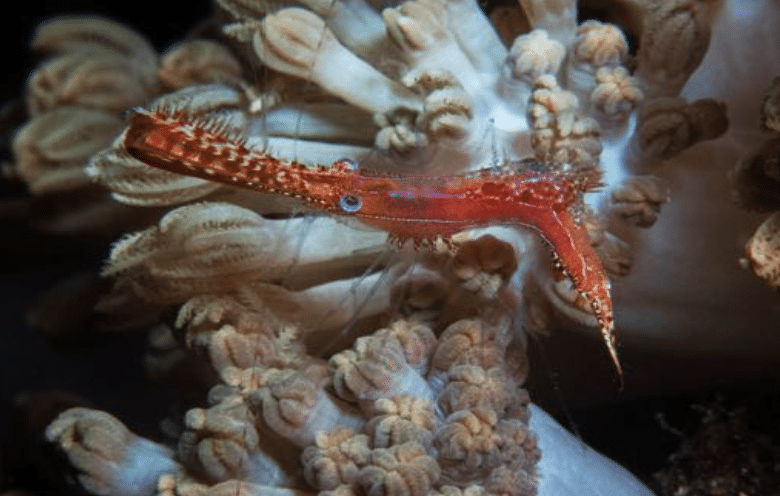
Long Nose Rock Shrimp
(Leander plumosus)
The Long Nose Rock Shrimp has an elongated, slender body and a distinctive long rostrum. It’s typically found in rocky crevices or coral reefs, where it camouflages itself among the substrate.
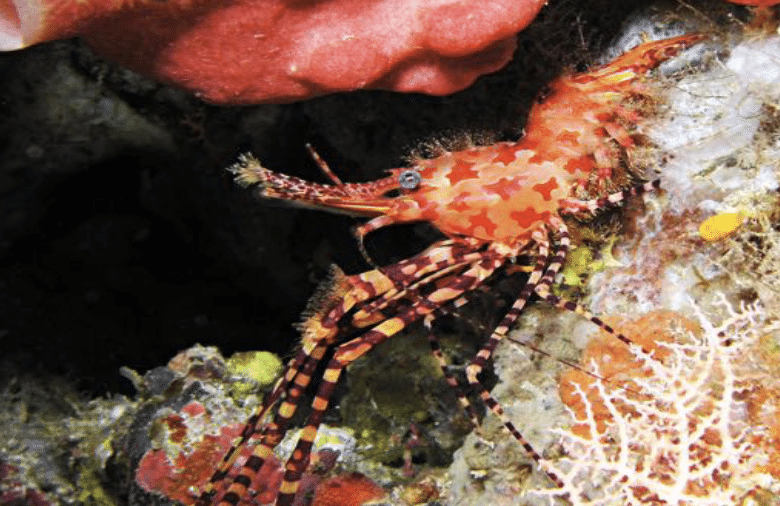
Marbled Shrimp Complex
(Saron spp.)
The Marbled Shrimp Complex includes various species of shrimp with marbled or mottled coloration. They’re often found in coral reef habitats and can exhibit a wide range of color patterns.
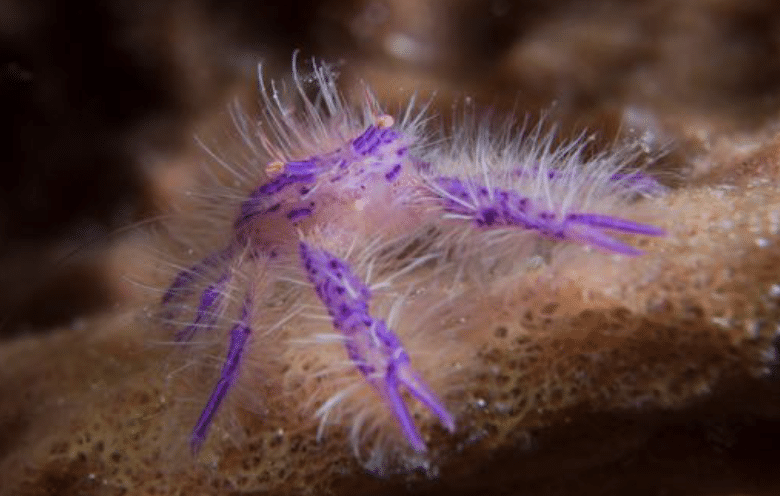
Hairy Squat Lobster
(Lauriea siagiani)
The Hairy Squat Lobster has a hairy or spiky appearance and is typically found hiding among coral rubble or rocky substrates. It feeds on detritus and small invertebrates.
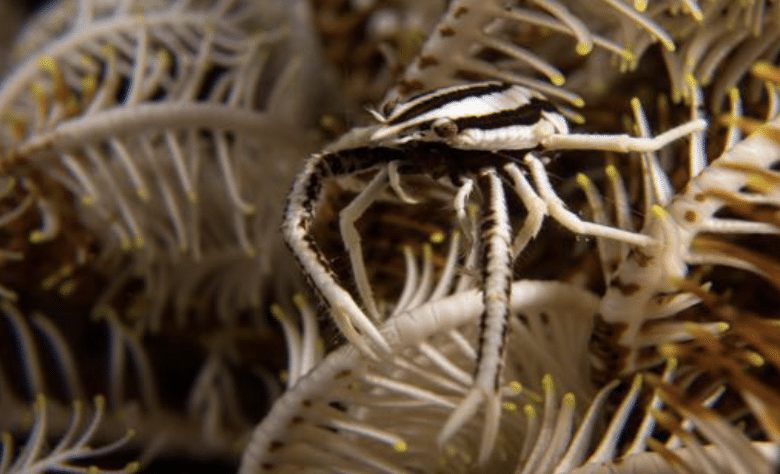
Elegant Crinoid Squat Lobster
(Allogalathea elengans)
The Elegant Crinoid Squat Lobster is a small, colorful crustacean often found living among crinoid arms. It has a vibrant coloration and delicate appendages, blending in seamlessly with its surroundings.
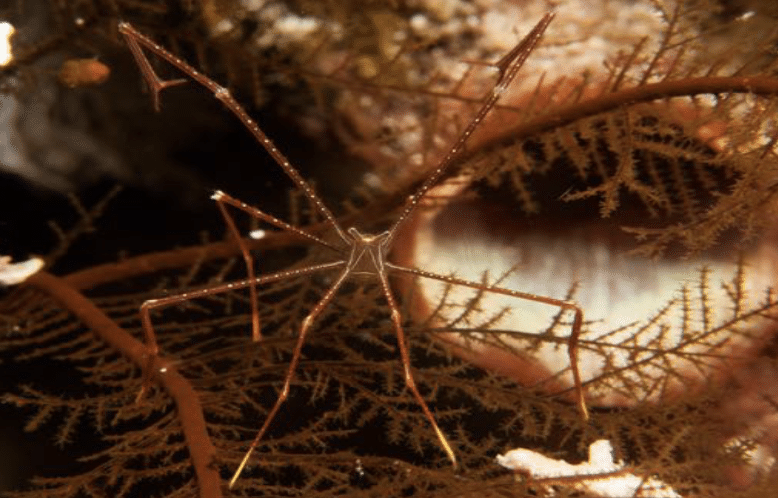
Spider Squat Lobster
(Chirostylus sandyi)
The Spider Squat Lobster has elongated legs resembling those of a spider, hence the name. It’s found in deep-sea environments, where it scavenges for food on the seafloor.
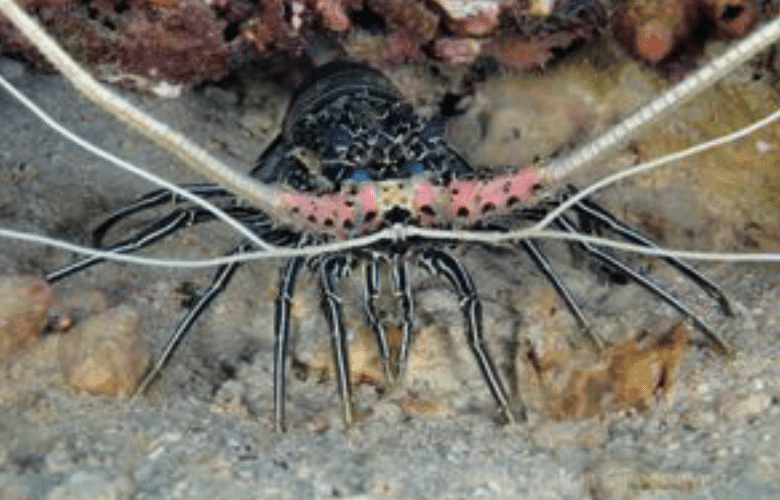
Painted Spiny Lobster
(Panulirus versicolor)
The Painted Spiny Lobster has a colorful body with blue and yellow markings. It’s found in tropical waters and coral reefs, where it scavenges for food at night.
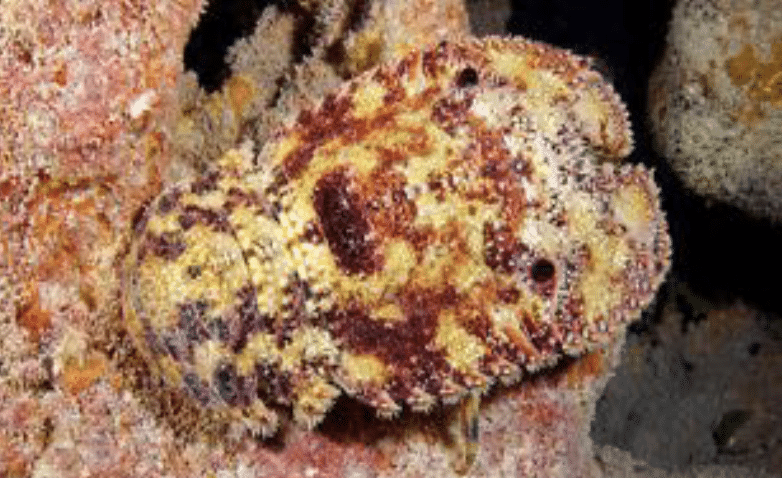
Sculptured Slipper Lobster
(Parribcus antarcticus)
The Sculptured Slipper Lobster has a flattened body with sculpted ridges and bumps. It’s commonly found in rocky habitats and caves, where it feeds on small invertebrates.
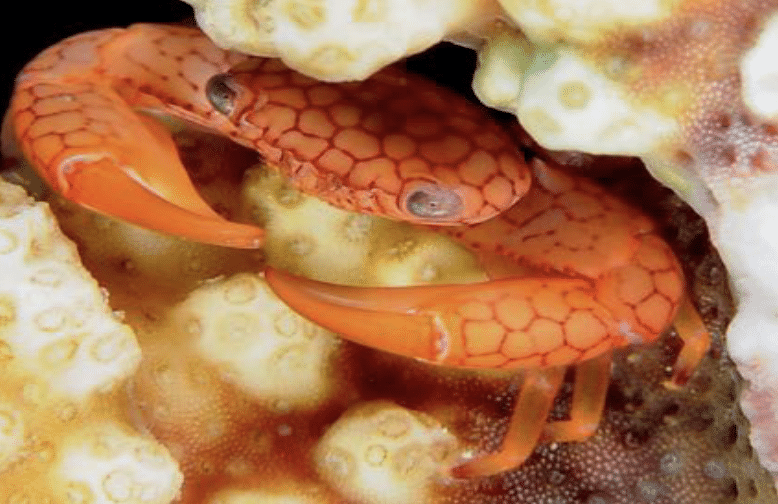
Guard Crab
(Trapezia intermedia)
The Guard Crab is a small crab species often found living in association with certain species of coral. It defends its host coral from predators and in return receives protection and shelter.
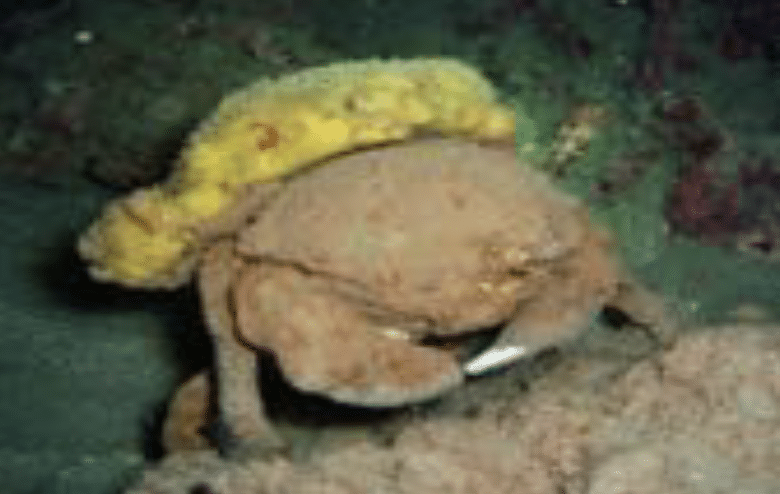
De Haan’s Sponge Crab
(Lauridromia dehaani)
De Haan’s Sponge Crab is a crab species that carries a sponge on its back for camouflage and protection. It’s often found in coral reef environments, where it blends in seamlessly with its surroundings.
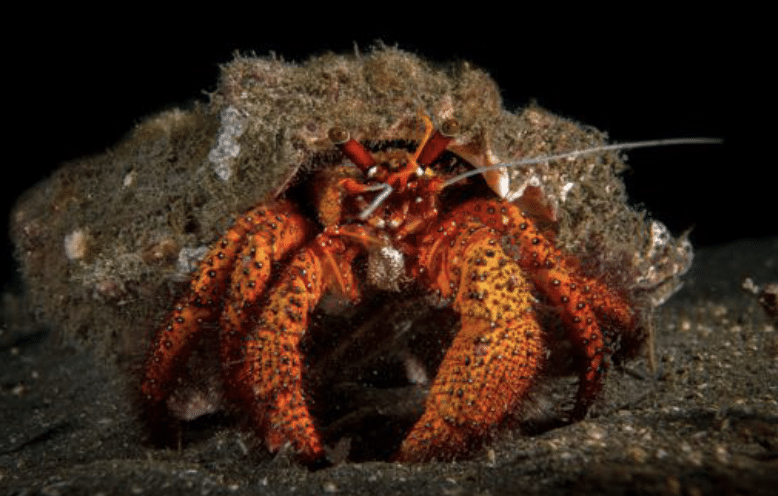
Spotted Hermit Crab
(Dardanus megistos)
he Spotted Hermit Crab is a species of hermit crab with a spotted or mottled coloration. It typically inhabits sandy or rocky substrates in tropical waters, where it scavenges for food and uses empty shells for protection.
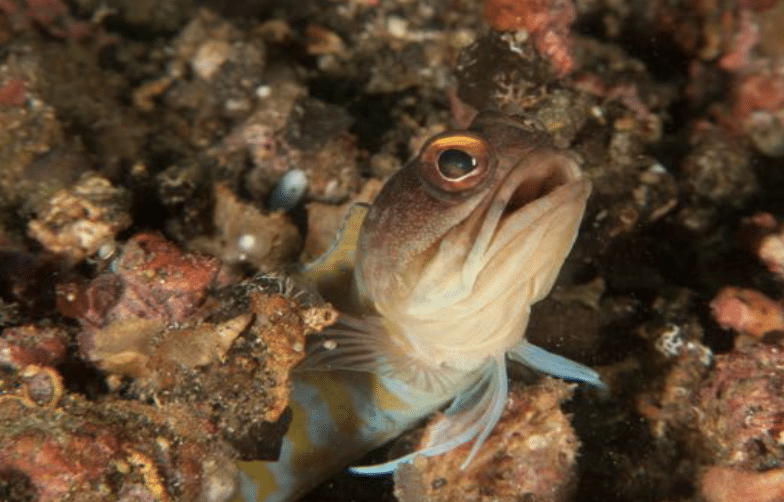
Yellow-barred Jawfish
(Opistognathus sp1)
The Yellow-barred Jawfish is a species of jawfish characterized by its distinctive yellow bars or stripes along its body. It inhabits sandy bottoms near coral reefs, where it constructs burrows for shelter.
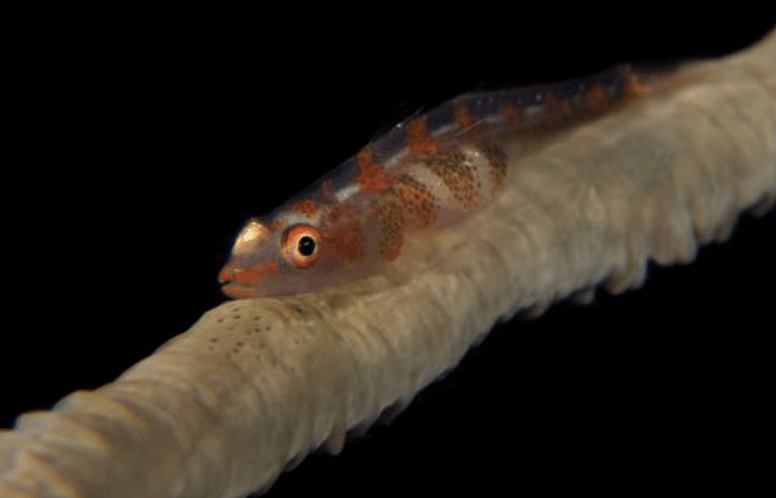
Wirecoral Goby
(Bryaninops yongei)
The Wirecoral Goby is a small, colorful fish often found hovering near wire corals in coral reef environments. It has a slender body and tends to dart in and out of the coral branches, using them for protection.
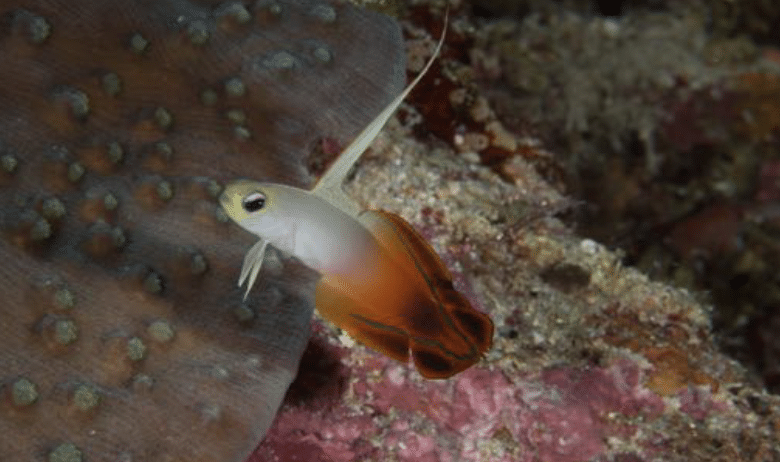
Fire Dartfish
(Nemateleotris magnifica)
The Fire Dartfish is known for its vibrant coloration, featuring bright red and orange hues. It’s typically found in sandy areas near coral reefs, where it darts in and out of its burrow in search of food.
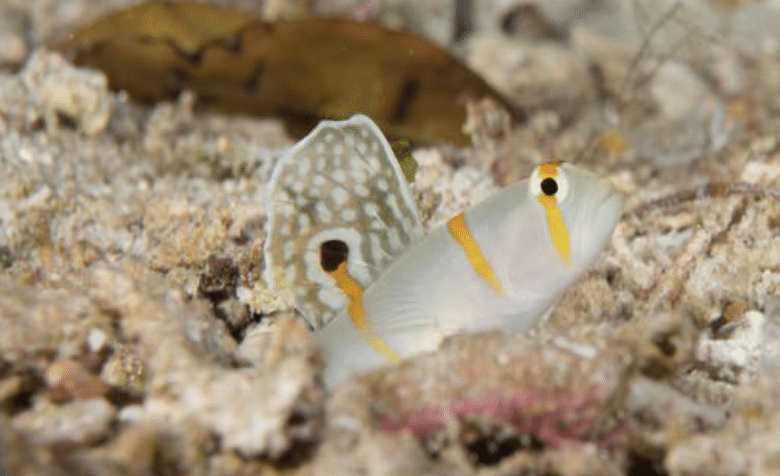
Randall’s Shrimp-goby
(Amblyeleotris randalli)
Randall’s Shrimp-goby is a symbiotic fish that forms a mutualistic relationship with certain species of pistol shrimp. It shares a burrow with the shrimp, which maintains the burrow, while the goby acts as a lookout for predators.
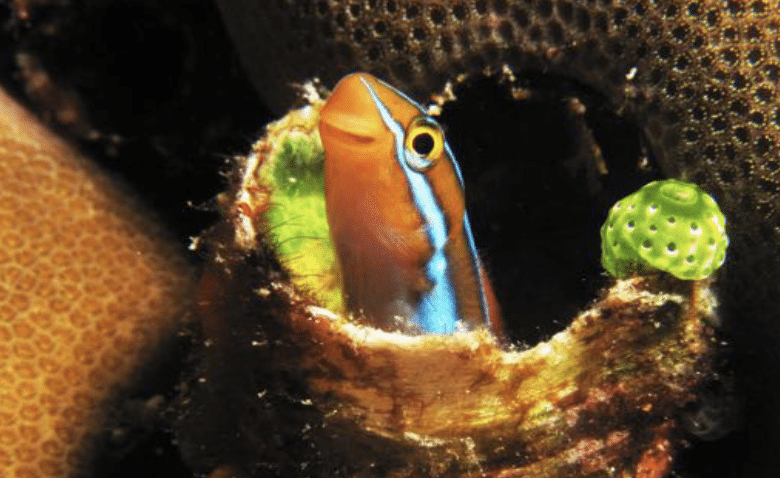
Bluestriped Fangblenny
(Plagiotremus rhinorhynchos)
The Bluestriped Fangblenny has a slender body with blue stripes and elongated teeth. It’s known for its mimicry behavior, imitating the appearance and behavior of cleaner wrasse to approach and nip at other fish.
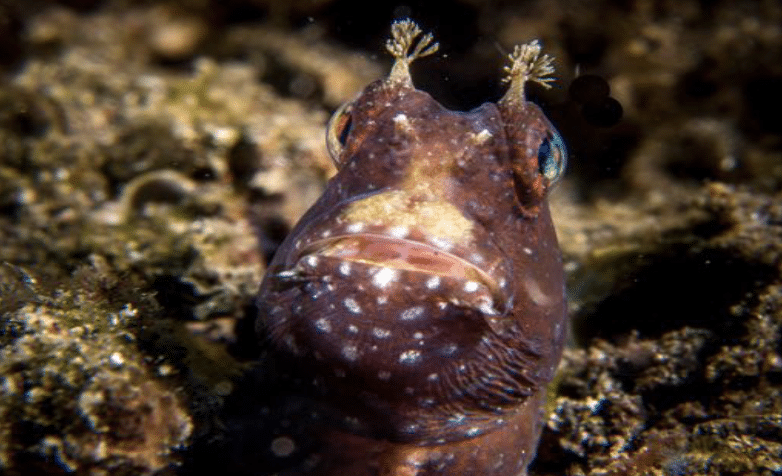
Starry Blenny
(Salarias ramosus)
The Starry Blenny is named for the star-like markings on its body. It’s commonly found in shallow waters near coral reefs, where it feeds on algae and small invertebrates.
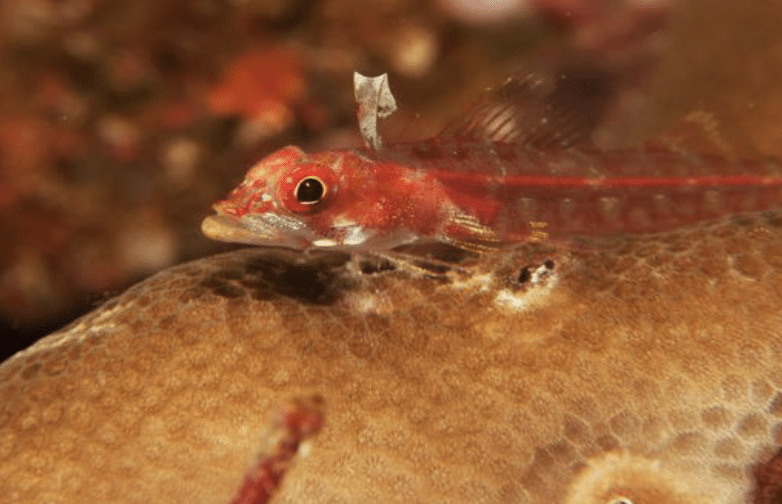
Miracle Threefin
(Enneapterygius mirabilis)
The Miracle Threefin is a small fish species found in coral reef habitats. It has a slender body and three distinct dorsal fins, giving it its name. It’s often found darting among crevices and coral branches.
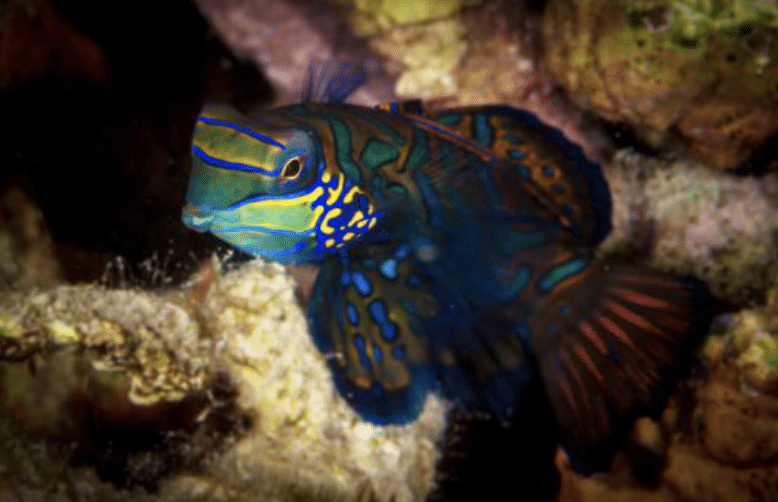
Mandarin fish
(Pterosynchiropus splendidus)
The Mandarin fish is renowned for its vibrant coloration and intricate patterning. It’s typically found in shallow coral reef habitats, where it feeds on small crustaceans and hides among coral branches.
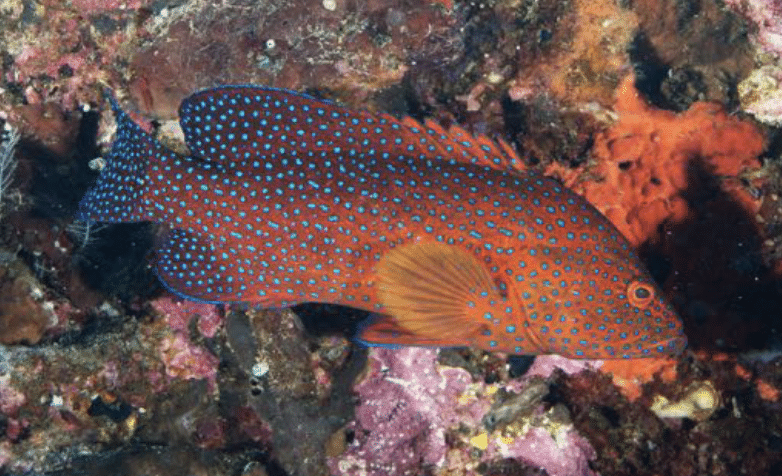
Coral Grouper
(Cephalopholis miniata)
The Coral Grouper is a medium-sized predatory fish commonly found in coral reef environments. It has a reddish-orange body with white spots and feeds on smaller fish and crustaceans.
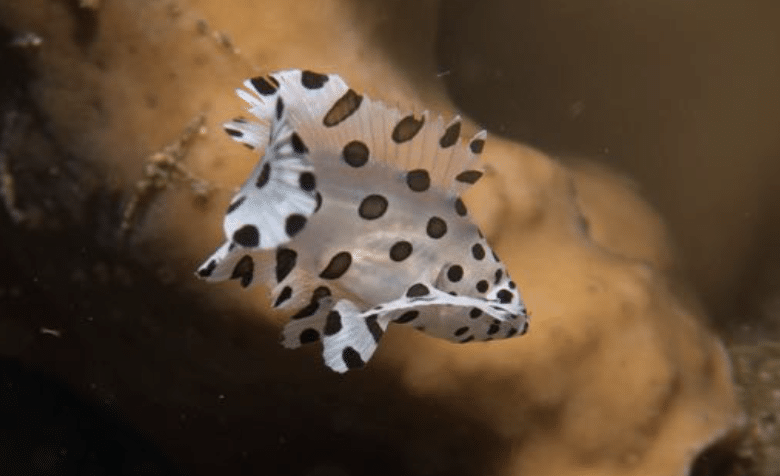
juv. Baramundi
(Cromileptes altivelis)
The juvenile Barramundi, also known as the Asian Sea Bass, has a silver body with dark vertical bands. It’s found in coastal waters and estuaries, where it feeds on small fish and crustaceans.
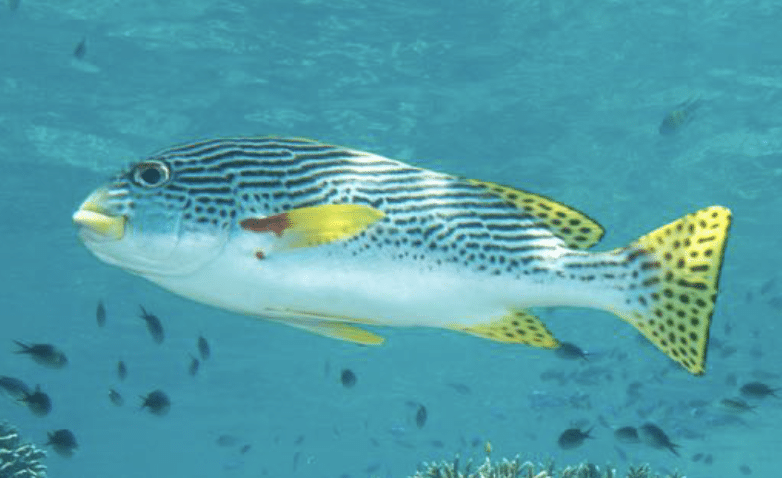
Diagonal banded Sweetlips
(Plectorhinchus lineatus)
The Diagonal banded Sweetlips is named for the diagonal stripes running along its body. It’s a large, schooling fish found in coral reef environments, where it feeds on small invertebrates and plankton.
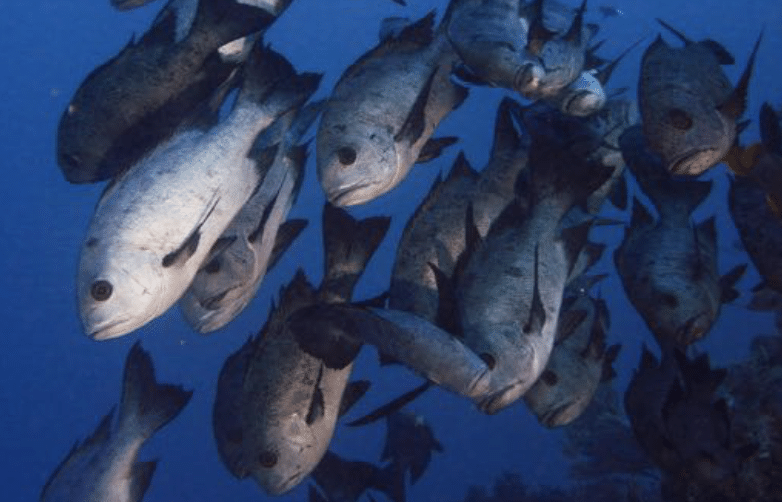
Black Snapper
(Macolor niger)
The Harlequin Sweetlips is known for its striking coloration, featuring a black body with white spots and orange markings. It’s commonly found in coral reef habitats, where it feeds on small fish and crustaceans.
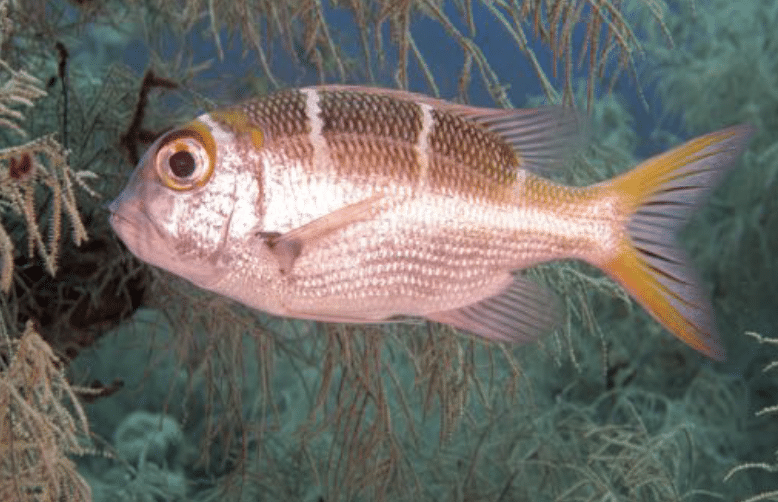
Redfin Bream
(Monotaxis heterodon)
The Redfin Bream is a colorful fish with distinctive red fins. It’s found in coastal waters and coral reefs, where it feeds on small invertebrates and plankton.
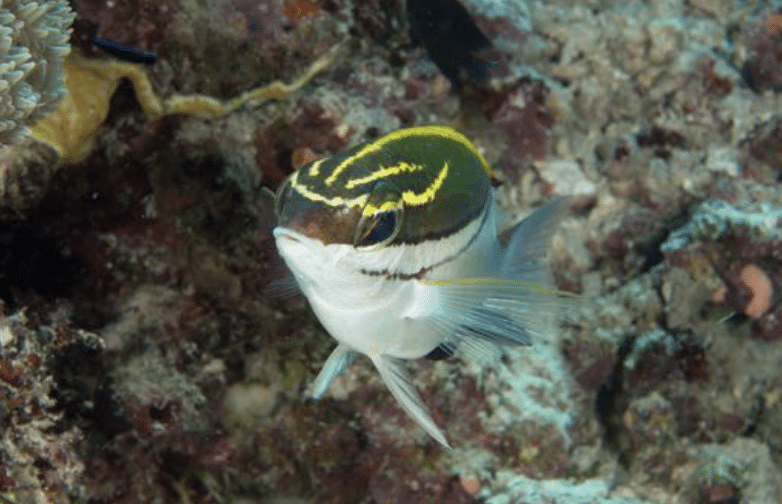
Bridled-monocle Bream
(Scolopsis bilineatus)
The Bridled-monocle Bream is characterized by its distinct facial markings, resembling a monocle. It’s typically found in sandy or rubble areas near coral reefs, where it feeds on small crustaceans and mollusks.
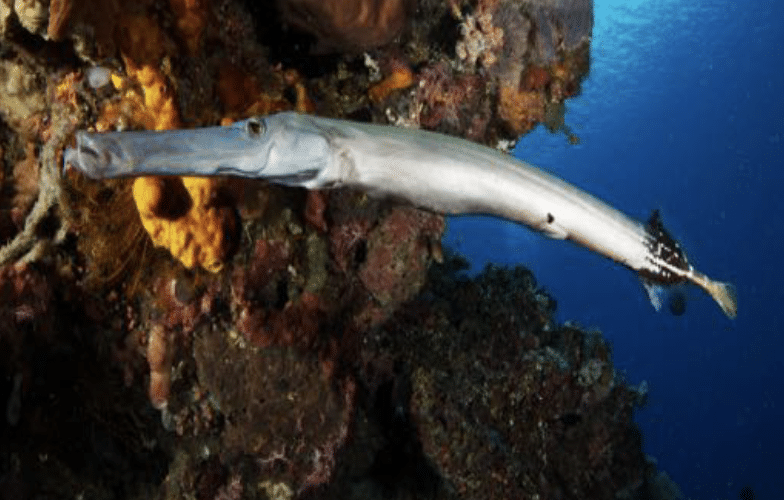
Trumpetfish
(Aulostumus chinesis)
The Trumpetfish has a long, slender body with a tubular snout resembling a trumpet. It’s often found hovering motionless near coral reefs or seagrass beds, using its camouflage to ambush prey.
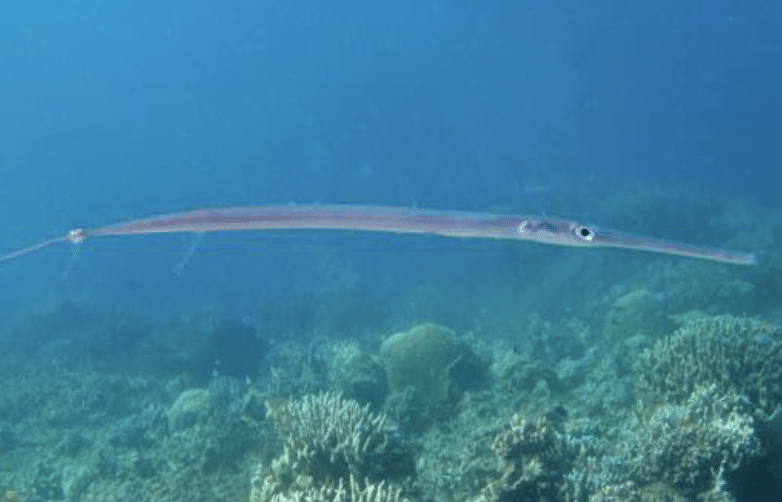
Cornetfish
(Fistularia commersonii)
The Cornetfish has an elongated, slender body with a tubular snout. It’s typically found in shallow coastal waters, where it feeds on small fish and crustaceans.
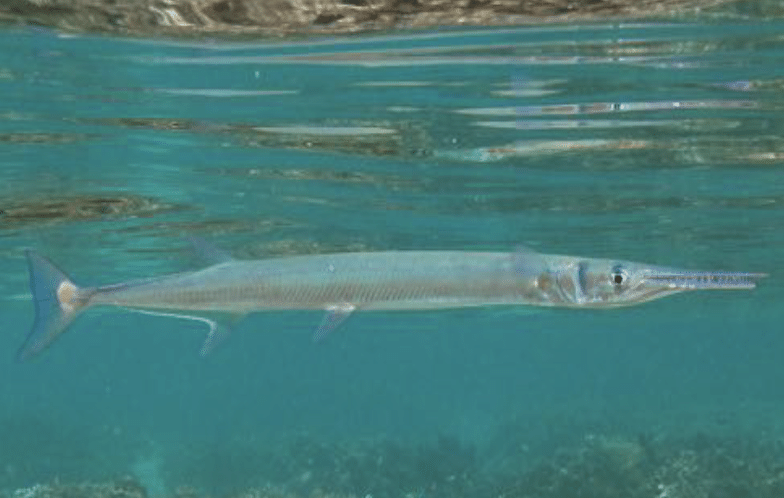
Crocodile Needlefish
(Tylosurus crocodilus)
The Crocodile Needlefish is named for its long, slender body and toothy snout resembling that of a crocodile. It’s commonly found in shallow coastal waters and estuaries, where it preys on small fish and crustaceans.
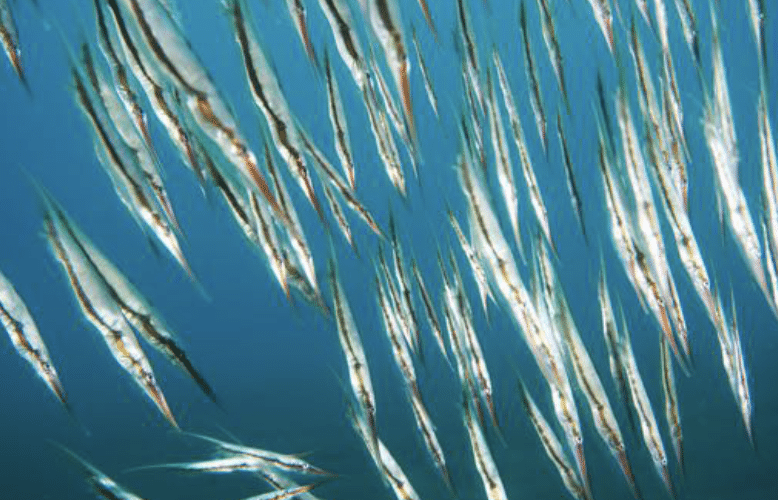
Shrimpfish
(Centiscus scutatus)
The Shrimpfish has a long, slender body with a flattened head and elongated snout. It’s often found swimming vertically in schools near the surface of the water, resembling shrimp.
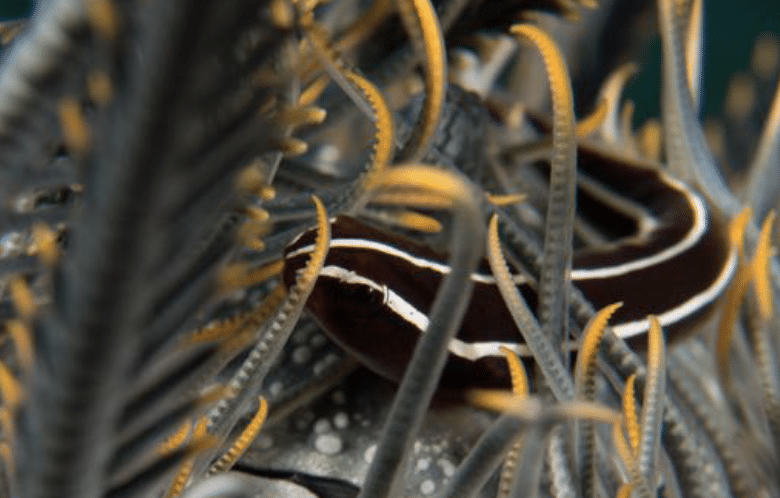
Threestripe Clingfish
(Discotrema crinophila)
The Threestripe Clingfish is a small, cryptic fish often found clinging to rocks or coral branches. It has three distinct stripes running along its body, providing camouflage in its environment.
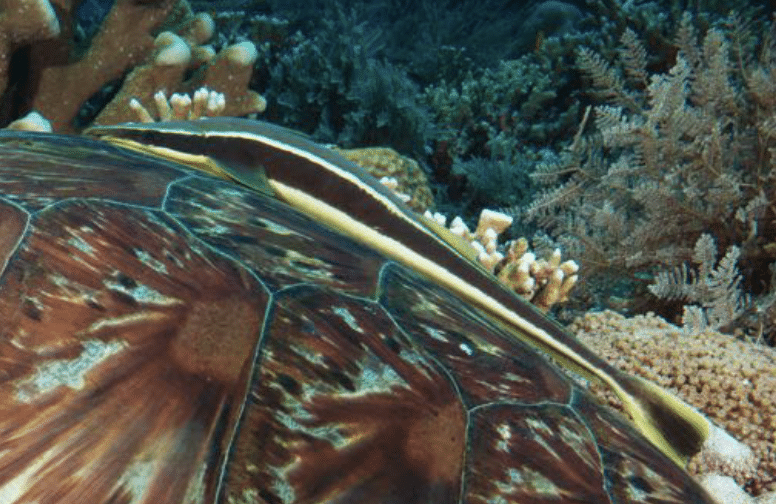
Sharksucker/Remora
(Echeneis naucrates)
The Sharksucker, also known as the Remora, is a fish with a flattened head and a modified dorsal fin forming a suction cup. It attaches itself to larger marine animals such as sharks and rays, using them for transportation and feeding on scraps.
